A Methodology for Estimating Frost Intensity and Damage in Orange Groves Using Meteosat Data: A Case Study in the Valencian Community
Abstract
1. Introduction
2. Materials and Methods
2.1. Study Area
2.2. Input Data
2.3. Workflow
3. Results
3.1. LST Evaluation
3.2. Methodology Application on a Single Pixel
3.3. LST Analysis on the Entire Valencian Community
3.4. Methodology Application on the Entire Valencian Community
3.5. Comparison with Citrus Agricultural Areas
3.6. Correlation Analysis with Altitude
4. Discussion
5. Conclusions
- Satellite-derived LST data, in this case from MSG, prove to be a useful and reliable tool for monitoring frost events;
- In the Valencian Community, there has been a decrease in frost occurrences over the past decade, particularly with regard to intense frost events;
- Citrus cultivation areas seem to be increasingly less exposed to frost risk in the study area, even at higher elevations above sea level.
Author Contributions
Funding
Data Availability Statement
Acknowledgments
Conflicts of Interest
Appendix A
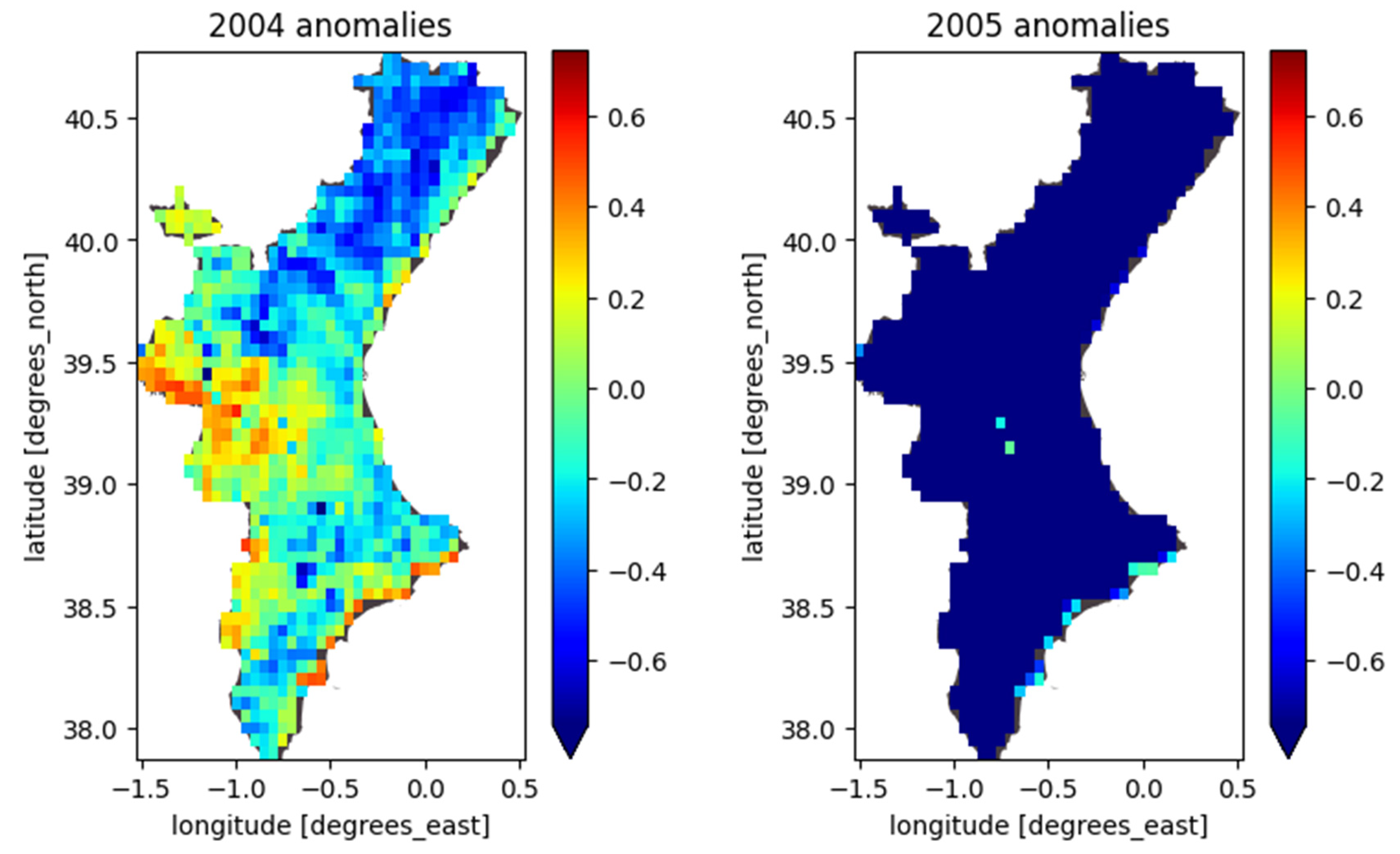


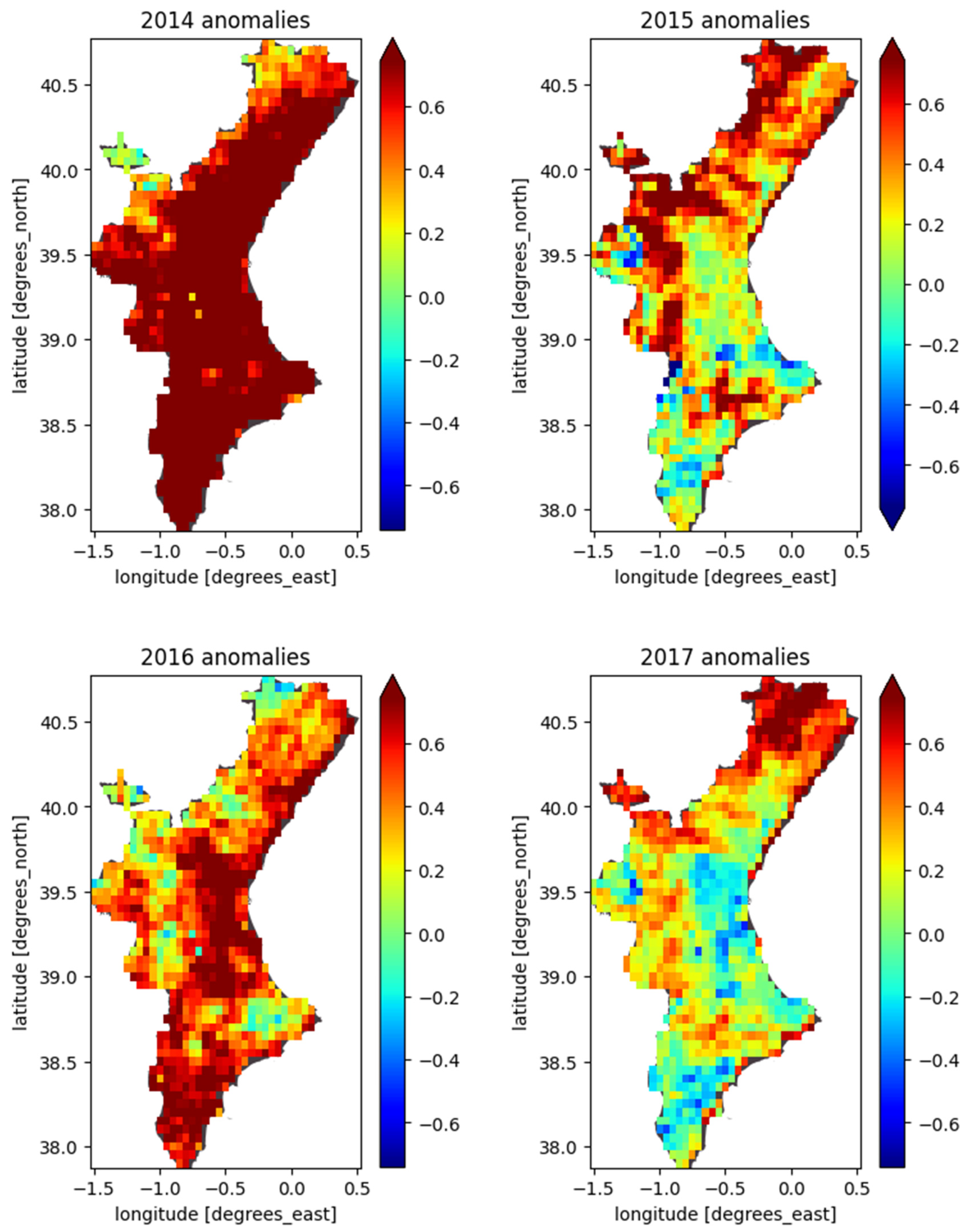

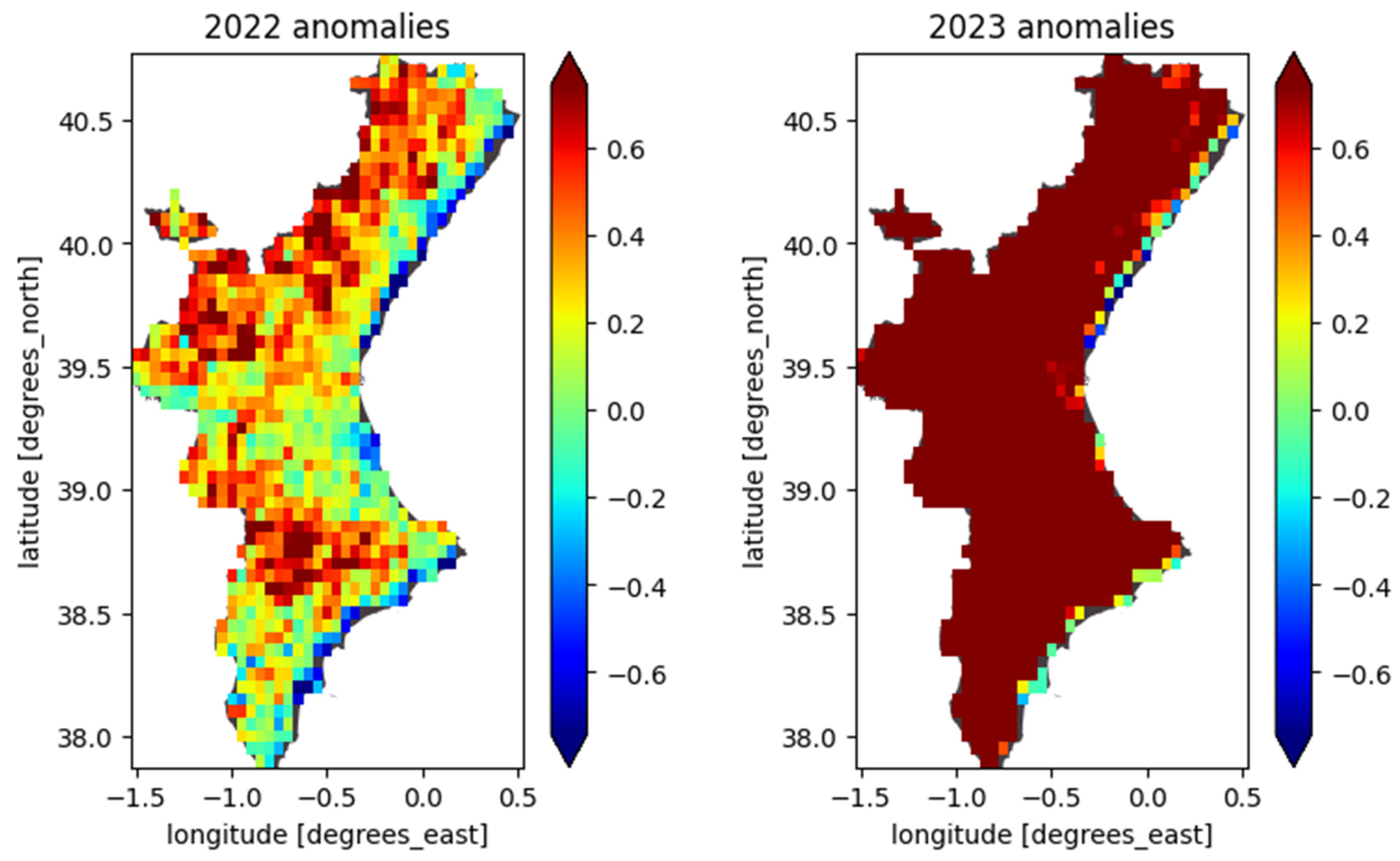
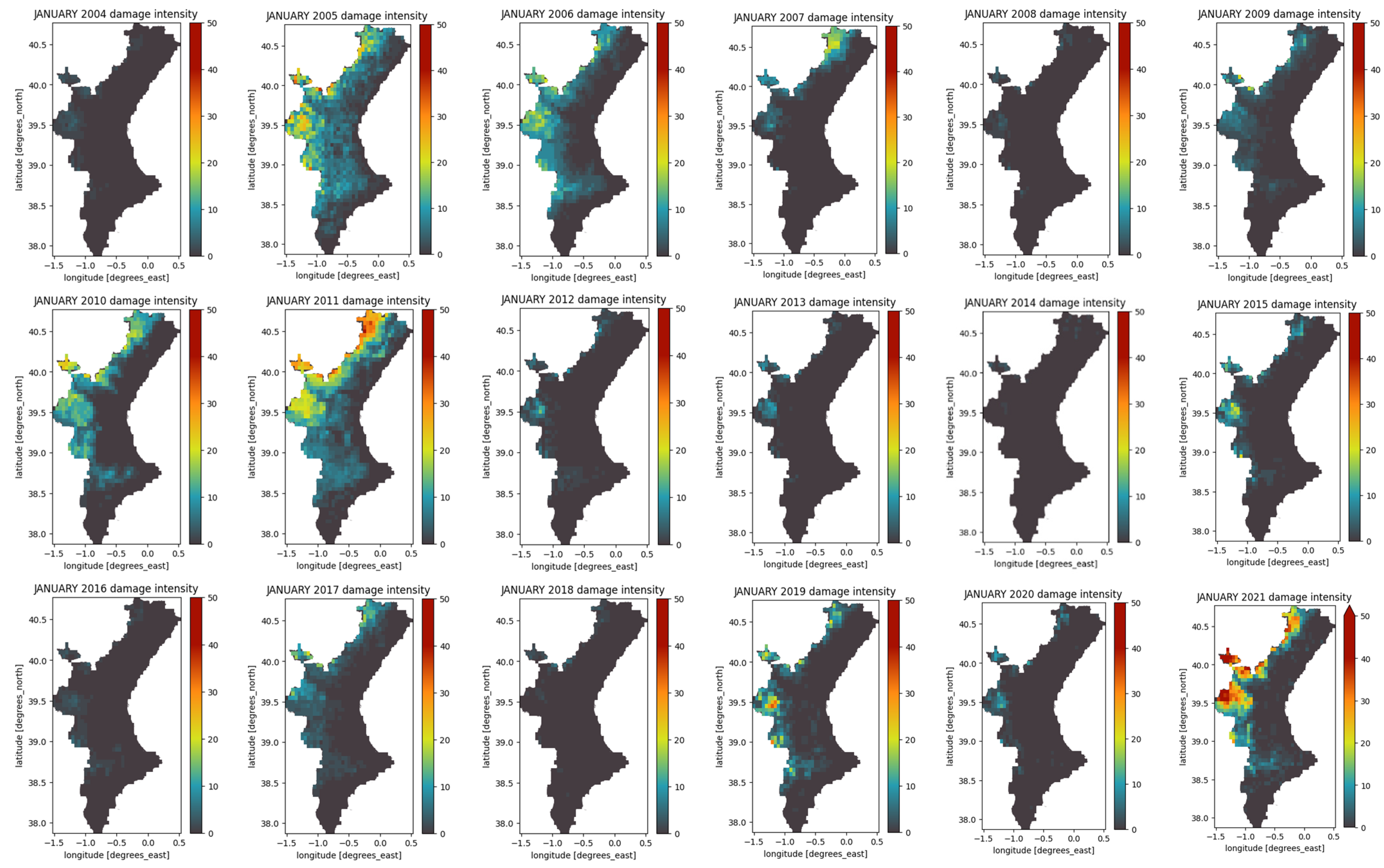
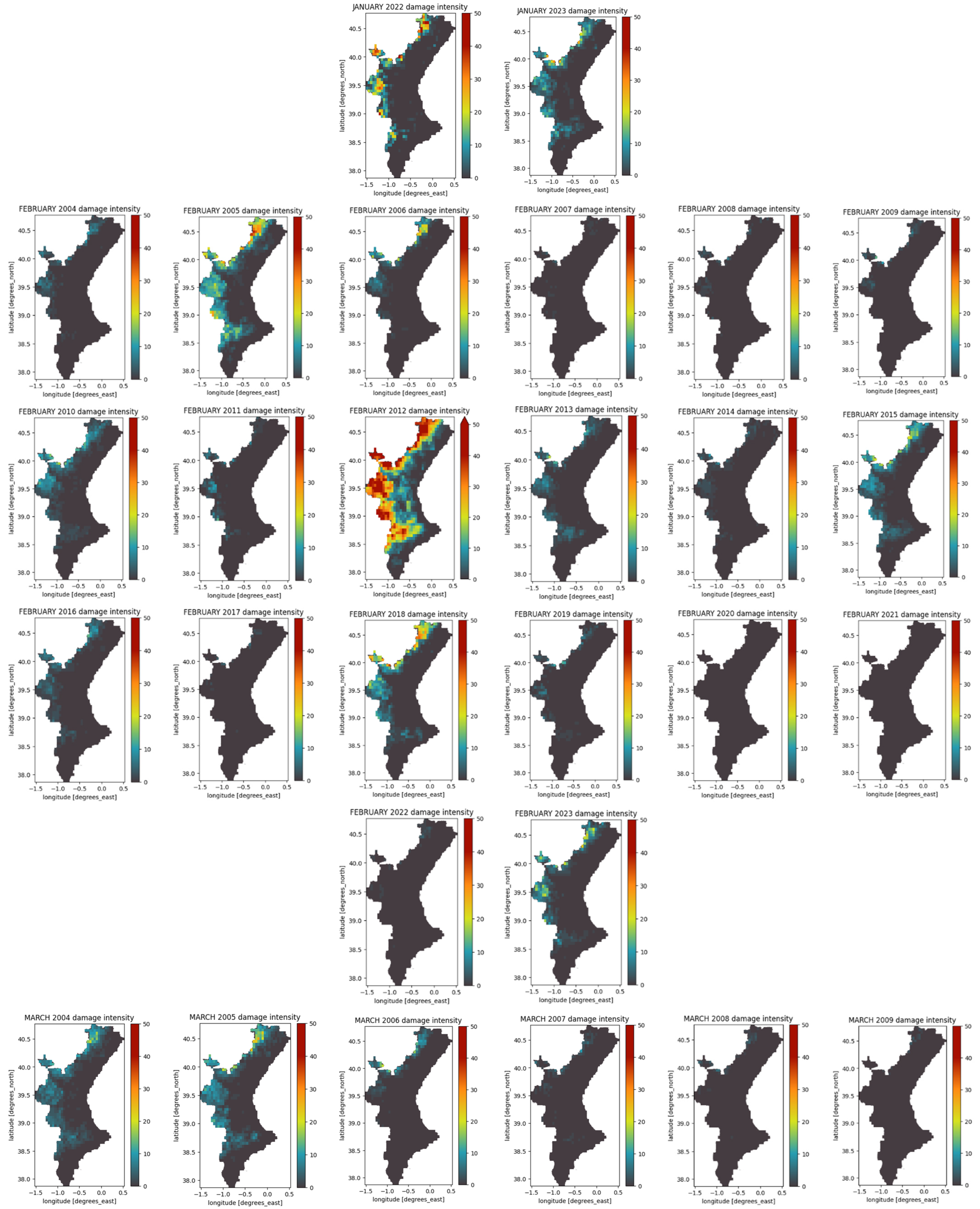

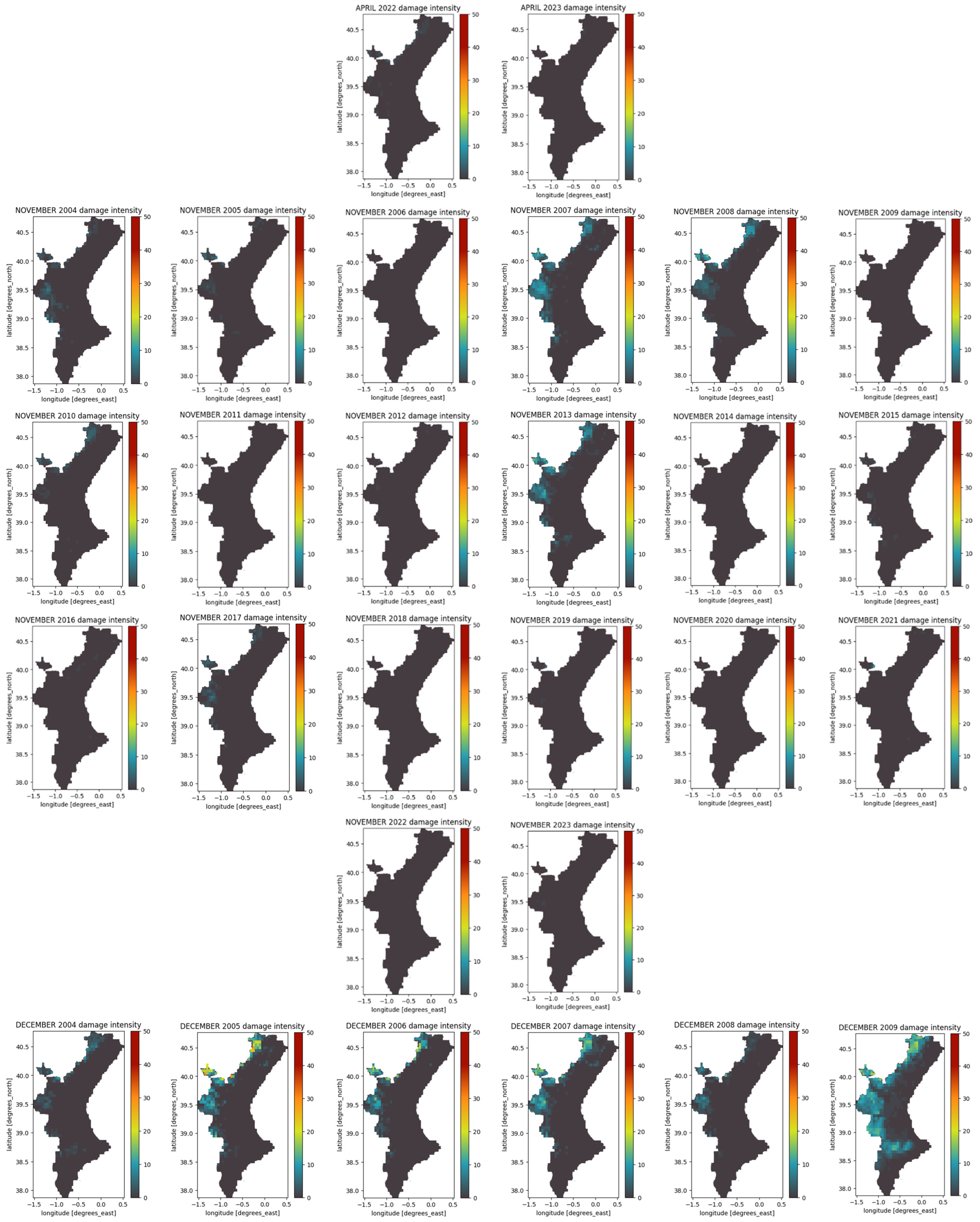

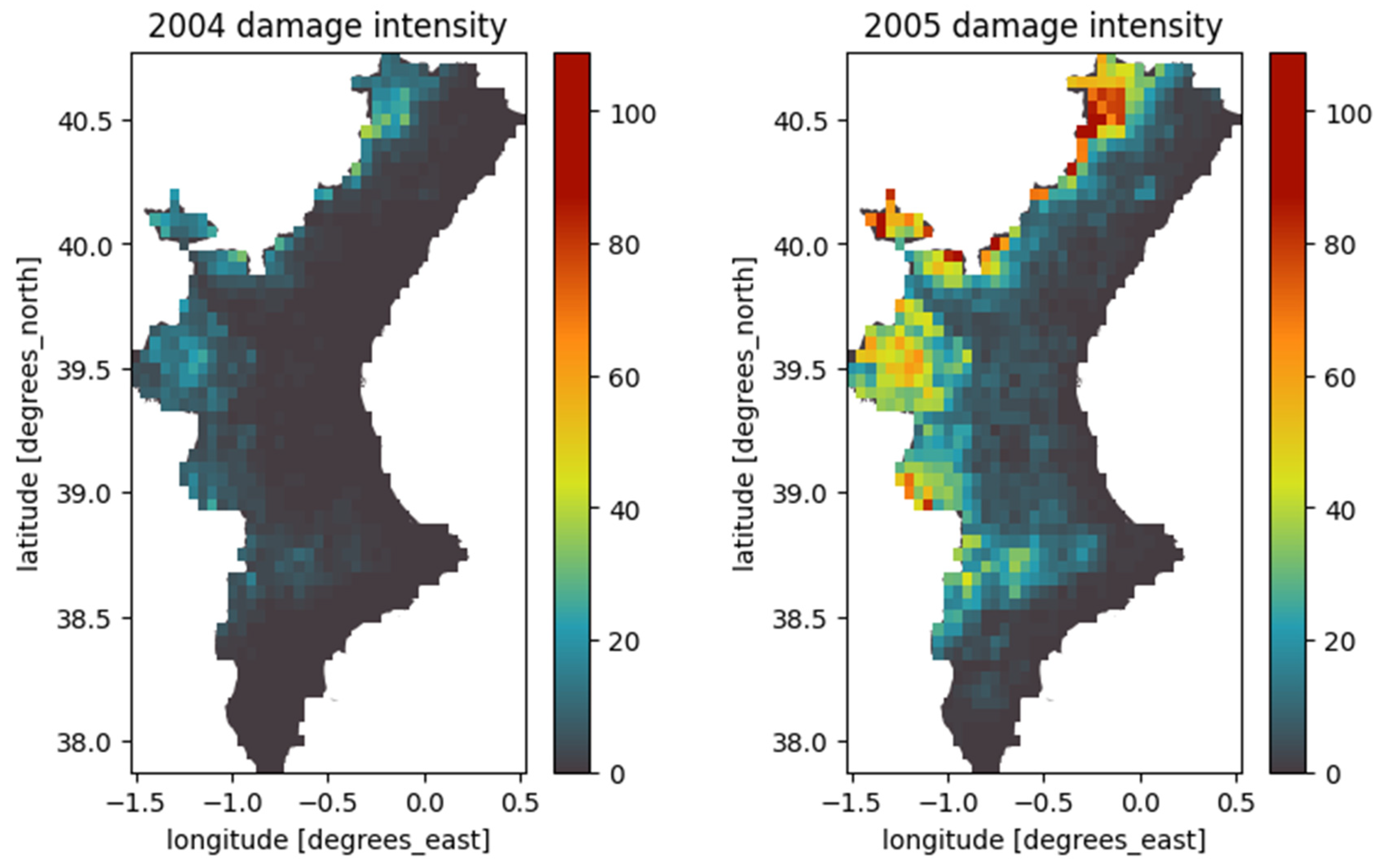
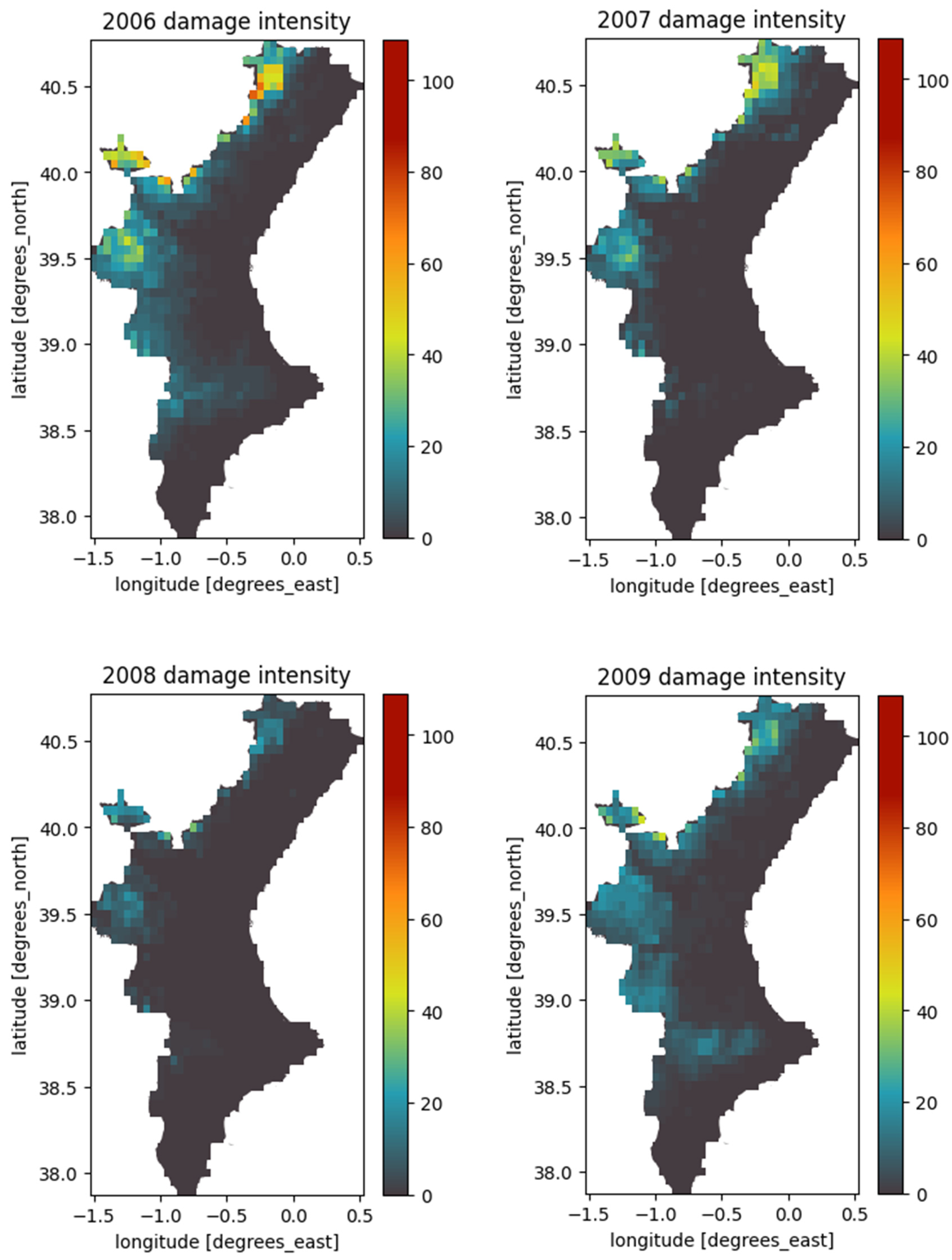

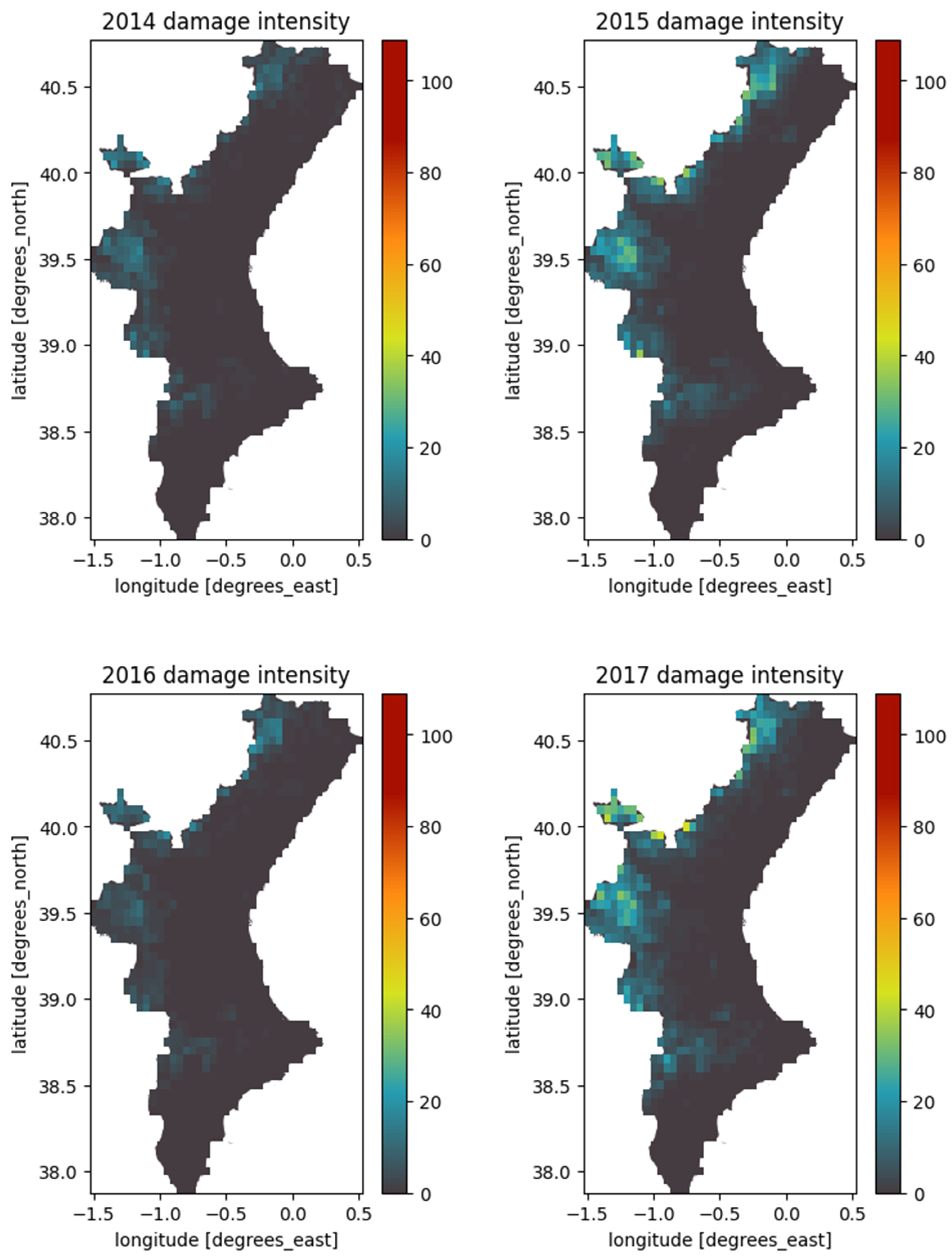
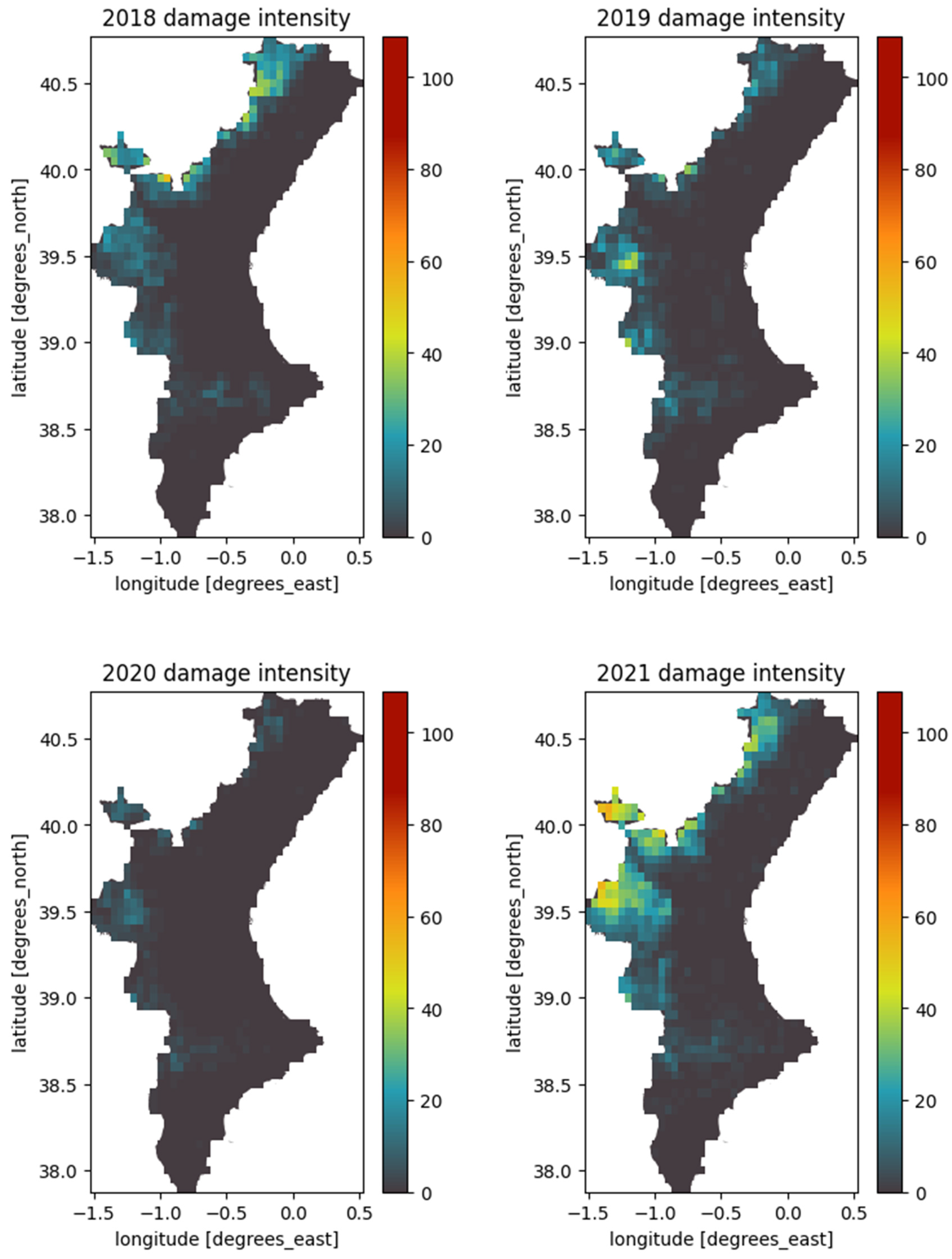
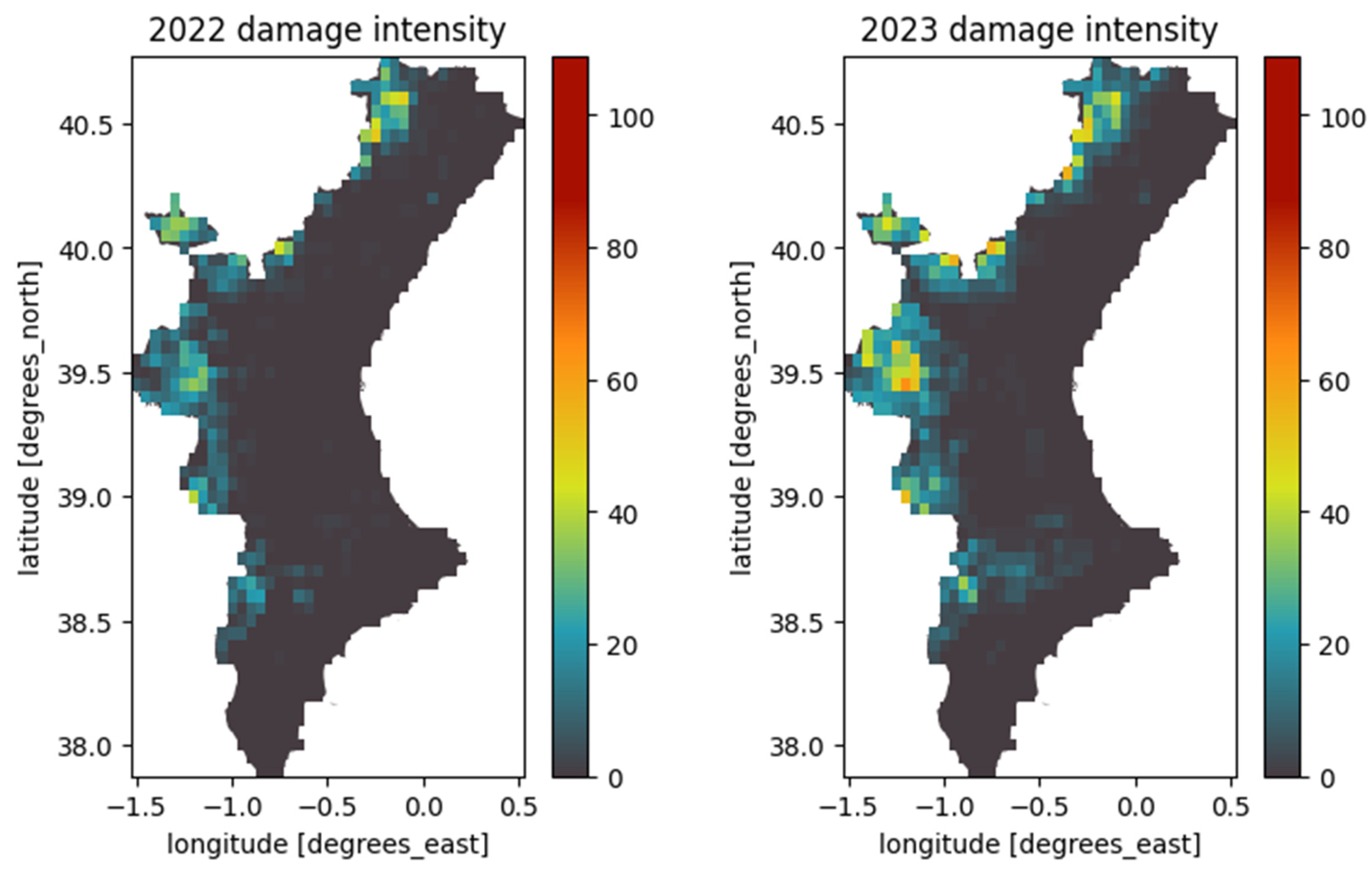
References
- Calvin, K.; Dasgupta, D.; Krinner, G.; Mukherji, A.; Thorne, P.W.; Trisos, C.; Romero, J.; Aldunce, P.; Barrett, K.; Blanco, G.; et al. IPCC, 2023: Climate Change 2023: Synthesis Report. Contribution of Working Groups I, II and III to the Sixth Assessment Report of the Intergovernmental Panel on Climate Change; Core Writing Team, Lee, H., Romero, J., Eds.; IPCC: Geneva, Switzerland, 2023. [Google Scholar] [CrossRef]
- Sobrino, J.A.; García-Monteiro, S.; Julien, Y. An analysis of the Lake Surface Water Temperature evolution of the world’s largest lakes during the years 2003-2020 using MODIS data. Recent Adv. Remote Sens. 2024, 1–9. [Google Scholar] [CrossRef]
- Parker, L.; Pathak, T.; Ostoja, S. Climate change reduces frost exposure for high-value California orchard crops. Sci. Total Environ. 2020, 762, 143971. [Google Scholar] [CrossRef] [PubMed]
- Olesen, J.; Trnka, M.; Kersebaum, K.; Skjelvåg, A.; Seguin, B.; Peltonen-Sainio, P.; Rossi, F.; Kozyra, J.; Micale, F. Impacts and adaptation of European crop production systems to climate change. Eur. J. Agron. 2010, 34, 96–112. [Google Scholar] [CrossRef]
- Fares, A.; Bayabil, H.K.; Zekri, M.; Mattos-Jr, D.; Awal, R. Potential climate change impacts on citrus water requirement across major producing areas in the world. J. Water Clim. Chang. 2017, 8, 576–592. [Google Scholar] [CrossRef]
- Makuvaro, V.; Walker, S.; Masere, T.P.; Dimes, J. Smallholder farmer perceived effects of climate change on agricultural productivity and adaptation strategies. J. Arid Environ. 2018, 152, 75–82. [Google Scholar] [CrossRef]
- Generalitat Valenciana. Estrategia Valenciana de Cambio Climático y Energía 2030. 2023. Available online: https://mediambient.gva.es/documents/163279113/168560465/Estrategia+Valenciana+de+Cambio+Clim%C3%A1tico++y+Energ%C3%ADa.pdf (accessed on 9 September 2024).
- Balfagón, D.; Arbona, V.; Gómez-Cadenas, A. El futuro de los cítricos: Impacto del cambio climático en la citricultura. Metode Sci. Stud. J. 2021, 12, 123–129. [Google Scholar] [CrossRef]
- Wang, S.; Xie, W.; Yan, X. Effects of future climate change on citrus quality and yield in China. Sustainability 2022, 14, 9366. [Google Scholar] [CrossRef]
- Karamidehkordi, E.; Sadati, S.a.H.; Tajvar, Y.; Mirmousavi, S.H. Climate change vulnerability and resilience strategies for citrus farmers. Environ. Sustain. Indic. 2023, 20, 100317. [Google Scholar] [CrossRef]
- Maracchi, G.; Sirotenko, O.; Bindi, M. Impacts of present and future climate variability on agriculture and forestry in the temperate regions: Europe. In Increasing Climate Variability and Change; Springer: Dordrecht, The Netherlands, 2005; pp. 117–135. [Google Scholar] [CrossRef]
- Alhader, M.M.; Hafez, M.S. The effect of some climatic variables and frosts waves on citrus crops. Al-Adab J. 2021, 138, 51–66. [Google Scholar] [CrossRef]
- Deng, G.; Zhang, H.; Yang, L.; Zhao, J.; Guo, X.; Ying, H.; Rihan, W.; Guo, D. Estimating Frost during Growing Season and Its Impact on the Velocity of Vegetation Greenup and Withering in Northeast China. Remote Sens. 2020, 12, 1355. [Google Scholar] [CrossRef]
- Liu, Q.; Piao, S.; Janssens, I.A.; Fu, Y.; Peng, S.; Lian, X.; Ciais, P.; Myneni, R.B.; Peñuelas, J.; Wang, T. Extension of the growing season increases vegetation exposure to frost. Nat. Commun. 2018, 9, 426. [Google Scholar] [CrossRef] [PubMed]
- Gu, L.; Hanson, P.J.; Mac Post, W.; Kaiser, D.P.; Yang, B.; Nemani, R.; Pallardy, S.G.; Meyers, T. The 2007 eastern US spring freeze: Increased cold damage in a warming world? BioScience 2008, 58, 253–262. [Google Scholar] [CrossRef]
- Li, W.; Huang, J.; Yang, L.; Chen, Y.; Fang, Y.; Jin, H.; Sun, H.; Huang, R. A practical remote sensing monitoring framework for late frost damage in wine grapes using Multi-Source satellite data. Remote Sens. 2021, 13, 3231. [Google Scholar] [CrossRef]
- Sakai, A.; Larcher, W. Frost Survival of Plants: Responses and Adaptation to Freezing Stress. 1987. Available online: https://link.springer.com/book/10.1007/978-3-642-71745-1 (accessed on 6 February 2025).
- Snyder, R.L.; Melo-Abreu, J. Frost Protection: Fundamentals, Practice and Economics; FAO Environment and Natural Resources Service Series No. 10; FAO: Rome, Italy, 2005; Volume 1, Available online: http://hdl.handle.net/10400.5/4727 (accessed on 6 February 2025).
- Caselles, V.; Sobrino, J. Determination of frosts in orange groves from NOAA-9 AVHRR data. Remote Sens. Environ. 1989, 29, 135–146. [Google Scholar] [CrossRef]
- Peterson, A.G.; Abatzoglou, J.T. Observed changes in false springs over the contiguous United States. Geophys. Res. Lett. 2014, 41, 2156–2162. [Google Scholar] [CrossRef]
- Allstadt, A.J.; Vavrus, S.J.; Heglund, P.J.; Pidgeon, A.M.; Thogmartin, W.E.; Radeloff, V.C. Spring plant phenology and false springs in the conterminous US during the 21st century. Environ. Res. Lett. 2015, 10, 104008. [Google Scholar] [CrossRef]
- Zabihi, H.; Vogeler, I.; Amin, Z.M.; Gourabi, B.R. Mapping the sensitivity of citrus crops to freeze stress using a geographical information system in Ramsar, Iran. Weather Clim. Extrem. 2016, 14, 17–23. [Google Scholar] [CrossRef]
- Reyes, J.J.; Elias, E. Spatio-temporal variation of crop loss in the United States from 2001 to 2016. Environ. Res. Lett. 2019, 14, 074017. [Google Scholar] [CrossRef]
- Geisel, P.M.; Unruh, C.L. Frost Protection for Citrus and Other Subtropicals (Publication 8100). University of California, Division of Agriculture and Natural Resources. 2003. Available online: https://escholarship.org/uc/item/5hh528qp (accessed on 6 February 2025).
- Fernández, C.F.; Castillo, I.P.; Lidón, A.G. Las Heladas en la Zona Citrícola de la Huerta Murciana; Serie Técnica Y De Estudio; Consejería De Agricultura, Agua Y Medio Ambiente: Murcia, Spain, 2003; Available online: https://www.carm.es/web/pagina?IDCONTENIDO=8358&IDTIPO=246&RASTRO=c498$m1259,20561 (accessed on 6 February 2025).
- Wang, S.; Chen, J.; Rao, Y.; Liu, L.; Wang, W.; Dong, Q. Response of winter wheat to spring frost from a remote sensing perspective: Damage estimation and influential factors. ISPRS J. Photogramm. Remote Sens. 2020, 168, 221–235. [Google Scholar] [CrossRef]
- Schmetz, J.; Pili, P.; Tjemkes, S.; Just, D.; Kerkmann, J.; Rota, S.; Ratier, A. An introduction to Meteosat Second Generation (MSG). Bull. Am. Meteorol. Soc. 2002, 83, 977–992. [Google Scholar] [CrossRef]
- Bernard, F.; Manolis, I.; Barat, I.; Alamañac, A.B.; Taboada, M.S.; Mingorance, P.; Ciapponi, A.; Cardone, T.; Nunez, I.F.; Garcia, A.; et al. The Copernicus land surface temperature monitoring (LSTM) mission: Design, technology and status. In Proceedings of the Sensors, Systems, and Next-Generation Satellites XXVII, Amsterdam, The Netherlands, 3–7 September 2023; Volume 12729, pp. 41–55. [Google Scholar] [CrossRef]
- Atzberger, C. Advances in remote sensing of agriculture: Context description, existing operational monitoring systems and major information needs. Remote Sens. 2013, 5, 949–981. [Google Scholar] [CrossRef]
- Pan, Q.; Lu, Y.; Hu, H.; Hu, Y. Review and research prospects on sprinkler irrigation frost protection for horticultural crops. Sci. Hortic. 2024, 326, 112775. [Google Scholar] [CrossRef]
- Venner, R.; Blank, S.C. Reducing Citrus Revenue Losses from Frost Damage: Wind Machines and Crop Insurance; Giannini Foundation Information Series, 95–1; Giannini Foundation of Agricultural Economics, University of California, Davis, Giannini Foundation: Berkeley, CA, USA, 1995; Available online: https://ideas.repec.org/p/ags/dgiais/251898.html (accessed on 6 February 2025).
- Ribeiro, A.C.; De Melo-Abreu, J.P.; Snyder, R.L. Apple orchard frost protection with wind machine operation. Agric. For. Meteorol. 2006, 141, 71–81. [Google Scholar] [CrossRef]
- Balawejder, M.; Matłok, N.; Piechowiak, T.; Puchalski, C. Flame Heat Sources as a Sustainable Method of Protecting Fruit Orchards against Frost in Poland. Sustainability 2024, 16, 2386. [Google Scholar] [CrossRef]
- Murray, V.; Ebi, K.L. IPCC Special Report on Managing the Risks of Extreme Events and Disasters to Advance Climate Change Adaptation (SREX). J. Epidemiol. Community Health 2012, 66, 759–760. [Google Scholar] [CrossRef] [PubMed]
- Generalitat Valenciana. Valencian Climate Change and Energy Strategy 2030. 2018. Available online: https://mediambient.gva.es/es/web/cambio-climatico/2020-2030 (accessed on 9 September 2024).
- Codoñer-Franch, P.; Valls-Bellés, V. Citrus as functional foods. Curr. Top. Nutraceutical Res. 2010, 8, 173–184. Available online: https://www.cabdirect.org/abstracts/20113371292.html (accessed on 23 September 2024).
- Zhong, G.; Nicolosi, E. Citrus origin, diffusion, and economic importance. In Compendium of Plant Genomes; Springer: Cham, Switzerland, 2020; pp. 5–21. [Google Scholar] [CrossRef]
- FAO. CITRUS FRUIT FRESH AND PROCESSED: Statistical Bulletin 2020. Citrus Fruit Statistical Compendium 2020. Rome. 2021. Available online: https://openknowledge.fao.org/server/api/core/bitstreams/4760a5b5-f3b2-41c7-8713-ccdb1a5f8c08/content (accessed on 23 September 2024).
- Da Silveira, F.; Da Silva, S.L.C.; Machado, F.M.; Barbedo, J.G.A.; Amaral, F.G. Farmers’ perception of the barriers that hinder the implementation of agriculture 4.0. Agric. Syst. 2023, 208, 103656. [Google Scholar] [CrossRef]
- Whiteman, T.M. Freezing Points of Fruits, Vegetables and Florist Stocks; U.S. Dept. of Agriculture, Agricultural Marketing Service, Marketing Research Division: Washington, DC, USA, 1957. [Google Scholar] [CrossRef]
- Conesa, N.A.; Nicolás, N.J.M.; Manera, N.F.J.; Porras, N.I. Frost damage in lemon orchards in the province of Murcia. Acta Hortic. 2015, 1065, 1417–1422. [Google Scholar] [CrossRef]
- Micheloud, N.G.; Castro, D.C.; Favaro, M.A.; Buyatti, M.A.; Pilatti, R.A.; Gariglio, N.F. Respuesta de Diferentes Variedades de Cítricos a los Daños Causados por Fuertes Heladas en la Región Central de Santa Fe. Rev. De La Fac. De Cienc. Agrar. UNCUYO 2017, 48, 43–56. Available online: https://revistas.uncu.edu.ar/ojs3/index.php/RFCA/article/view/3157 (accessed on 6 February 2025).
- Lobell, D.B.; Cahill, K.N.; Field, C.B. Historical effects of temperature and precipitation on California crop yields. Clim. Change 2007, 81, 187–203. [Google Scholar] [CrossRef]
- Ministerio de Agricultura, Pesca y Alimentación. Anuario de Estadística 2010. 2010. Available online: https://www.mapa.gob.es/es/estadistica/temas/ (accessed on 26 February 2024).
- Imbert, E. Citrus, Review of the 2004/2005 Season: Blowing Cold. Fruitrop (English Ed.). 2005. Available online: https://agritrop.cirad.fr/529612/ (accessed on 6 February 2025).
- Clarke, B. Report: Farmers and scientists. Sci. Commun. 2003, 25, 198–203. [Google Scholar] [CrossRef]
- Loboguerrero, A.M.; Boshell, F.; León, G.; Martinez-Baron, D.; Giraldo, D.; Mejía, L.R.; Díaz, E.; Cock, J. Bridging the gap between climate science and farmers in Colombia. Clim. Risk Manag. 2018, 22, 67–81. [Google Scholar] [CrossRef]
- Lou, W.; Qiu, X.; Wu, L.; Ni, H.; Tang, Q.; Mao, Y. Scheme of Weather-Based Indemnity indices for insuring against freeze damage to citrus orchards in Zhejiang, China. Agric. Sci. China 2009, 8, 1321–1331. [Google Scholar] [CrossRef]
- Ramón-Morte, A.; Moreno, D.P.; Moltó-Mantero, E. Mapping frost risk in fruit trees using GIS-based analysis: A case study in the province of Alicante (Spain). GeoFocus Int. Rev. Geogr. Inf. Sci. Technol. 2024, 33, 129–155. [Google Scholar] [CrossRef]
- Molitor, D.; Caffarra, A.; Sinigoj, P.; Pertot, I.; Hoffmann, L.; Junk, J. Late frost damage risk for viticulture under future climate conditions: A case study for the Luxembourgish winegrowing region. Aust. J. Grape Wine Res. 2013, 20, 160–168. [Google Scholar] [CrossRef]
Disclaimer/Publisher’s Note: The statements, opinions, and data contained in all publications are solely those of the individual author(s) and contributor(s) and not of MDPI and/or the editor(s). MDPI and/or the editor(s) disclaim responsibility for any injury to people or property resulting from any ideas, methods, instructions, or products referred to in the content. |
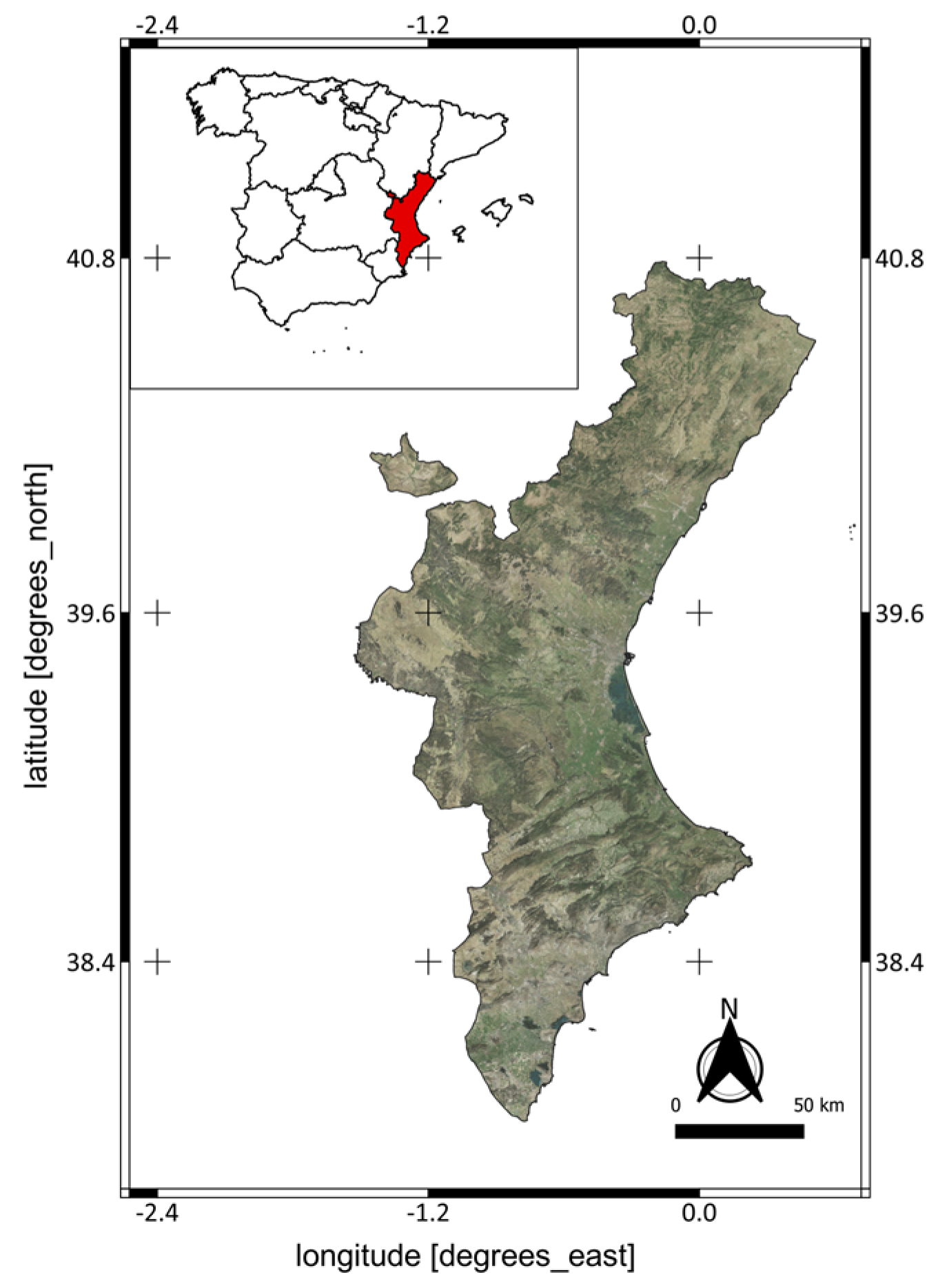
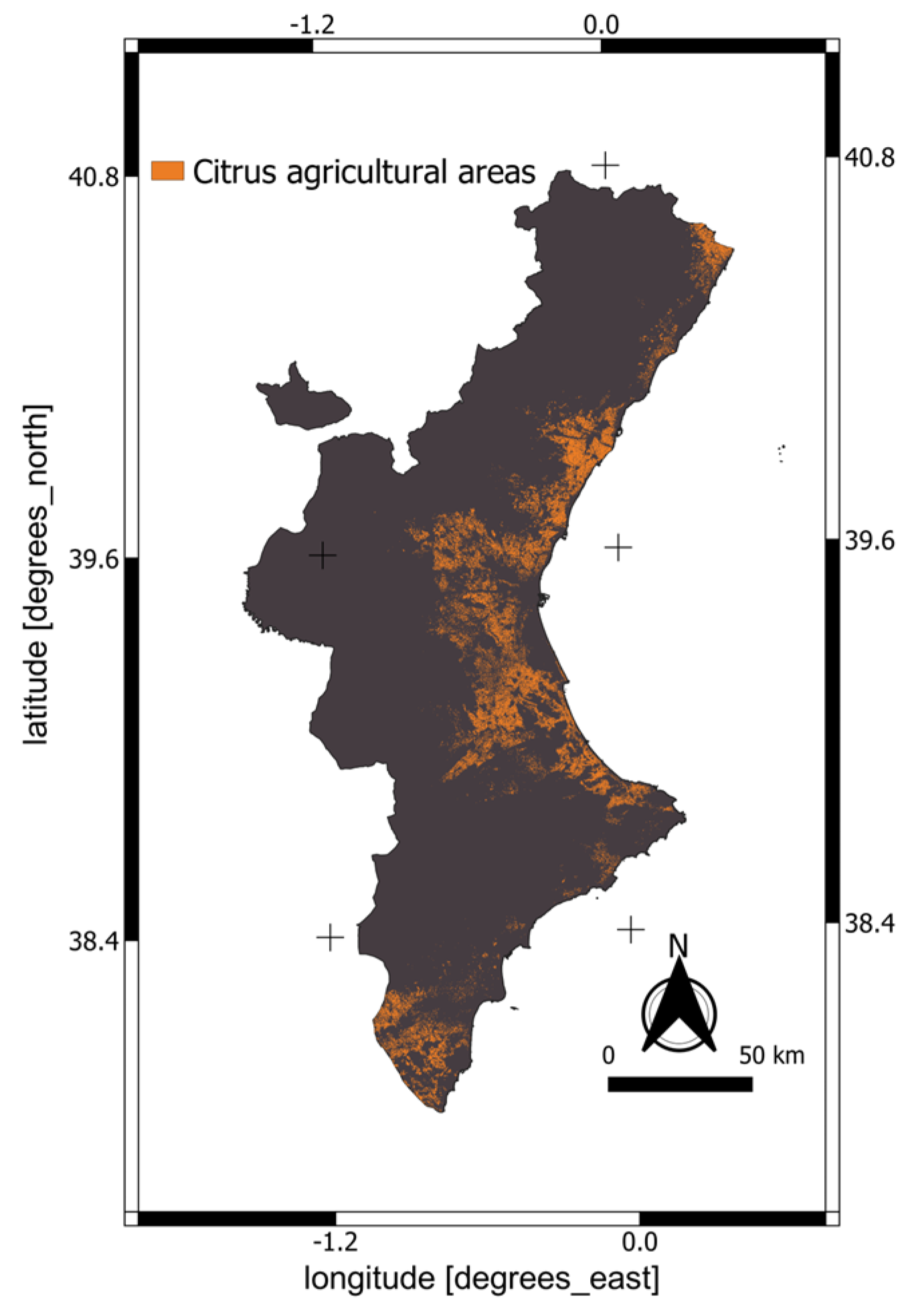
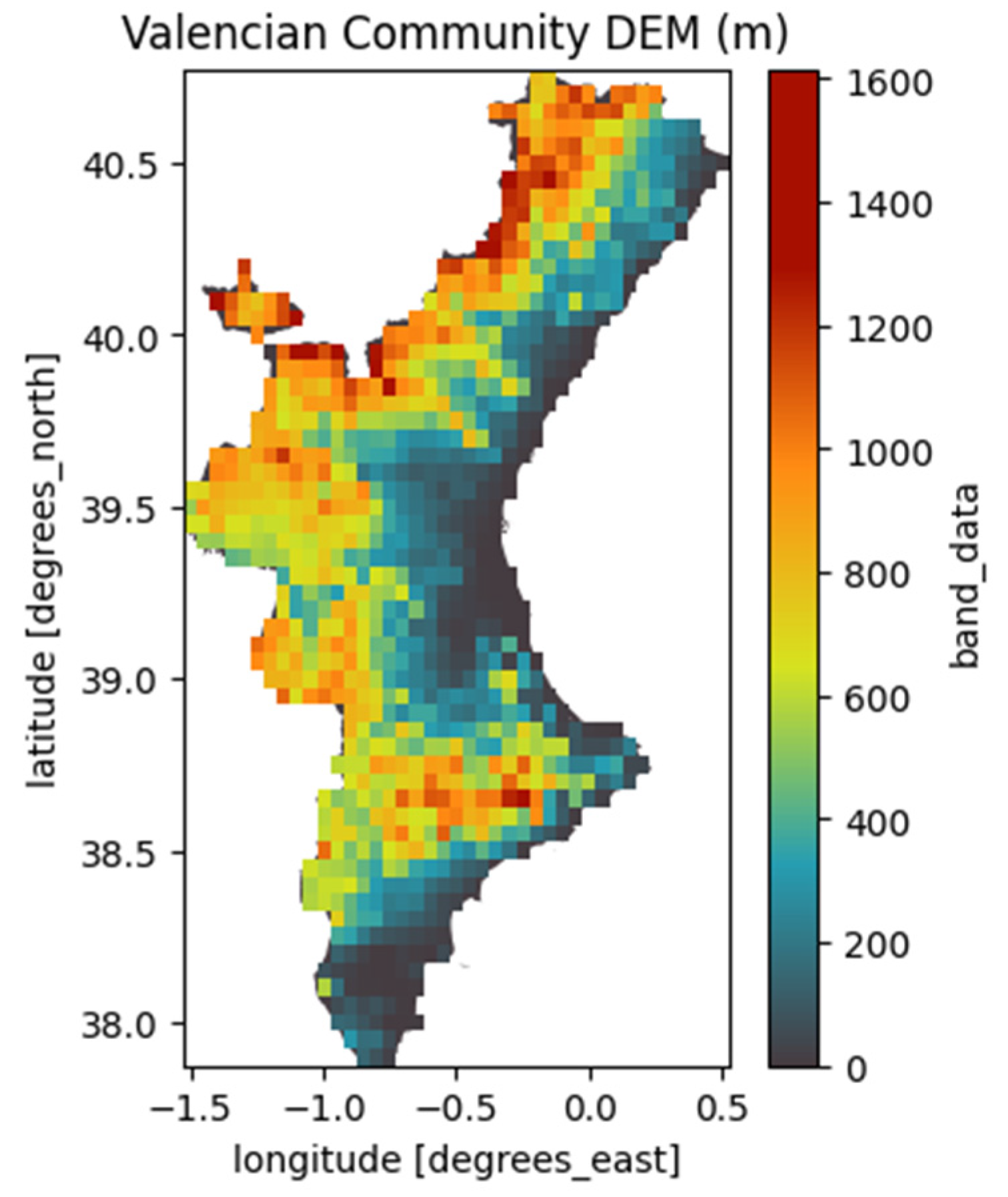

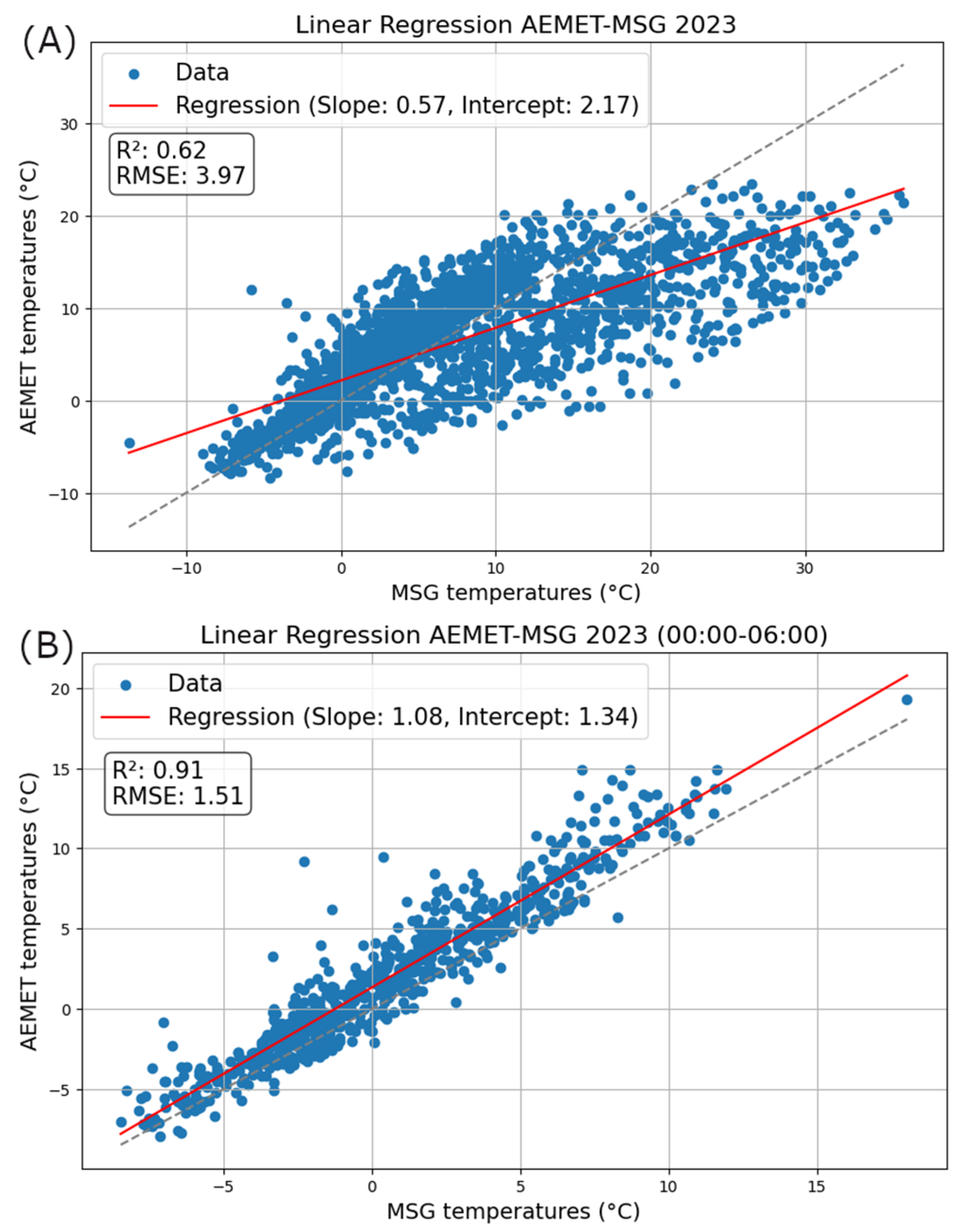
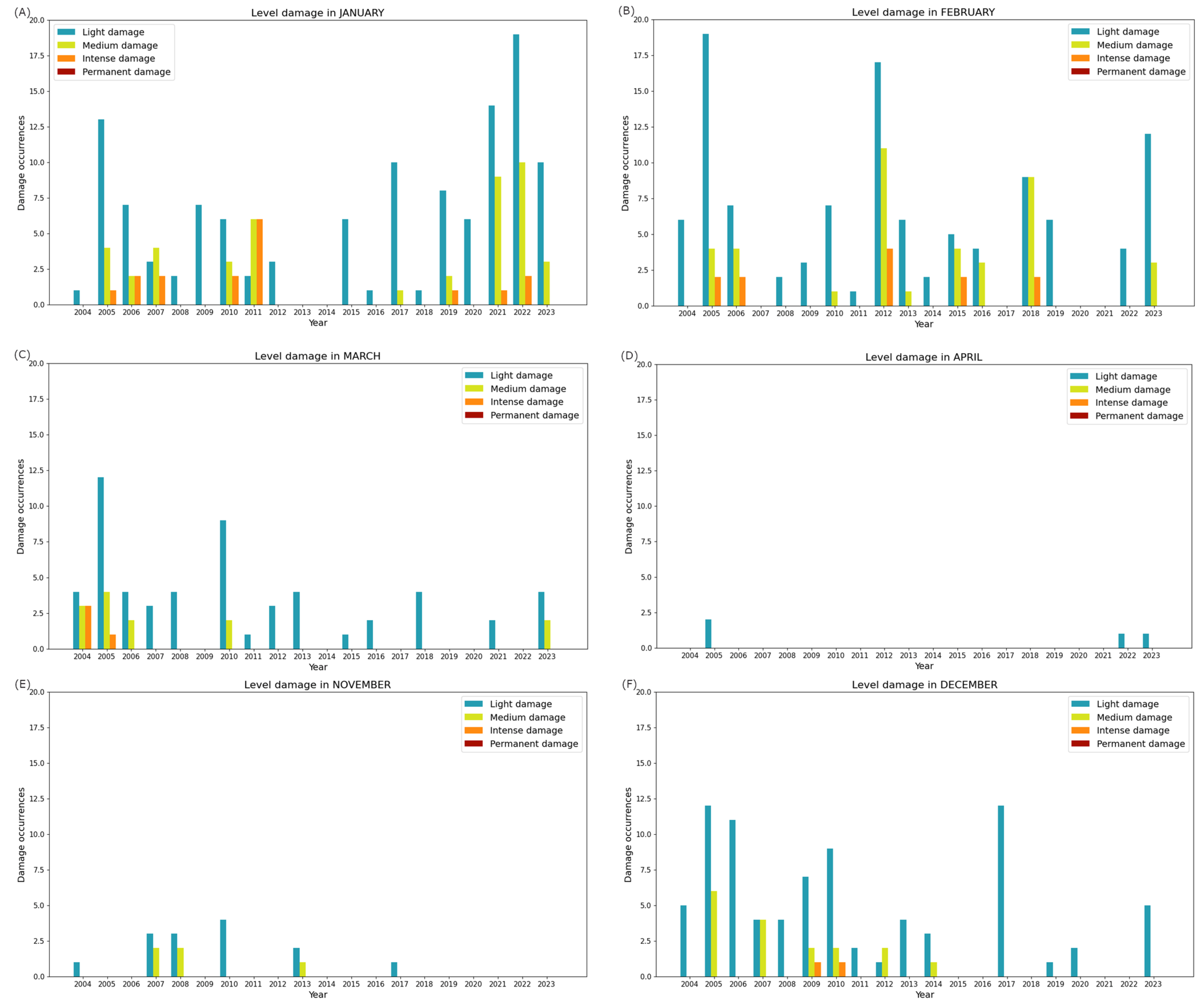

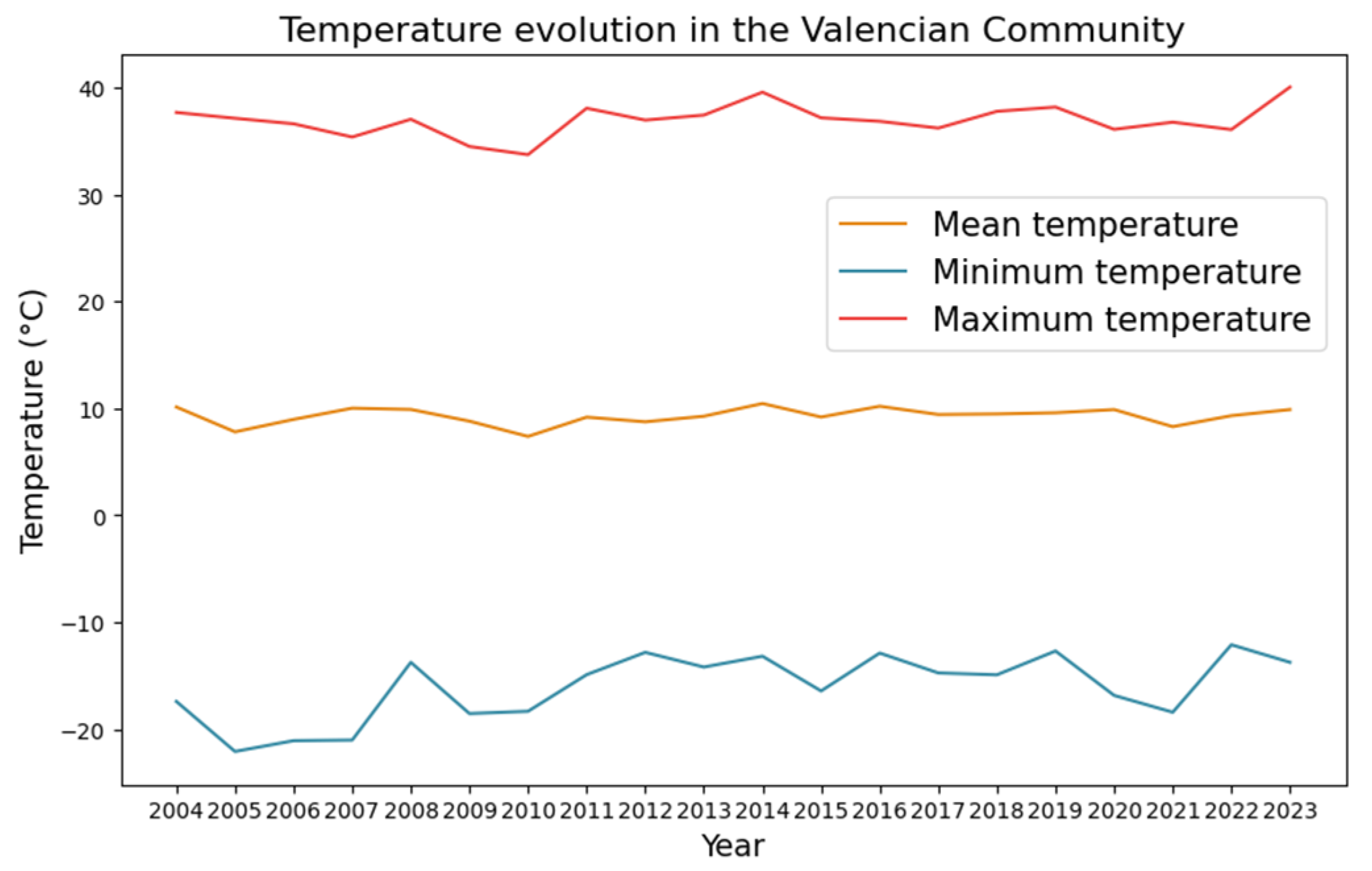
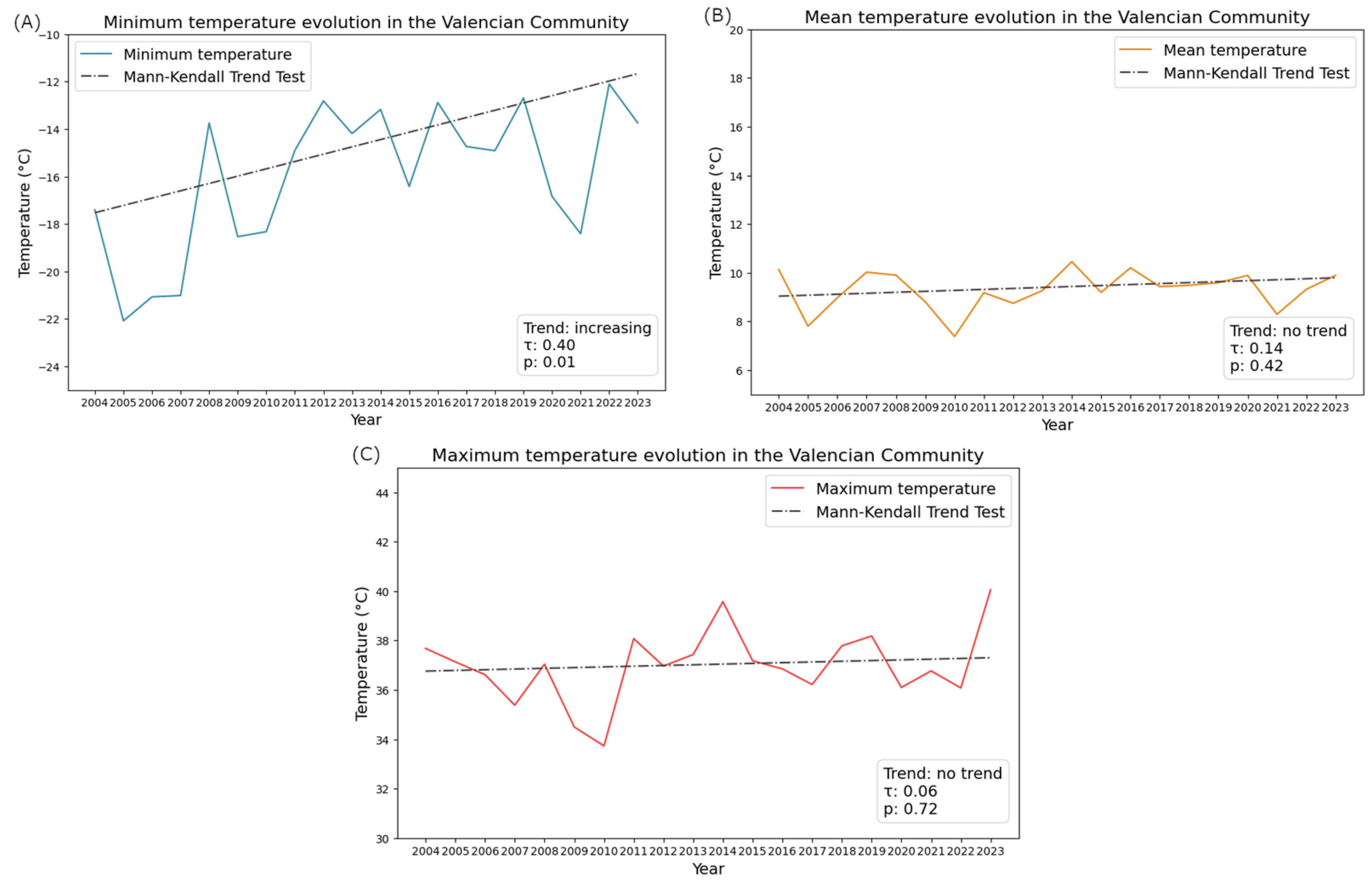
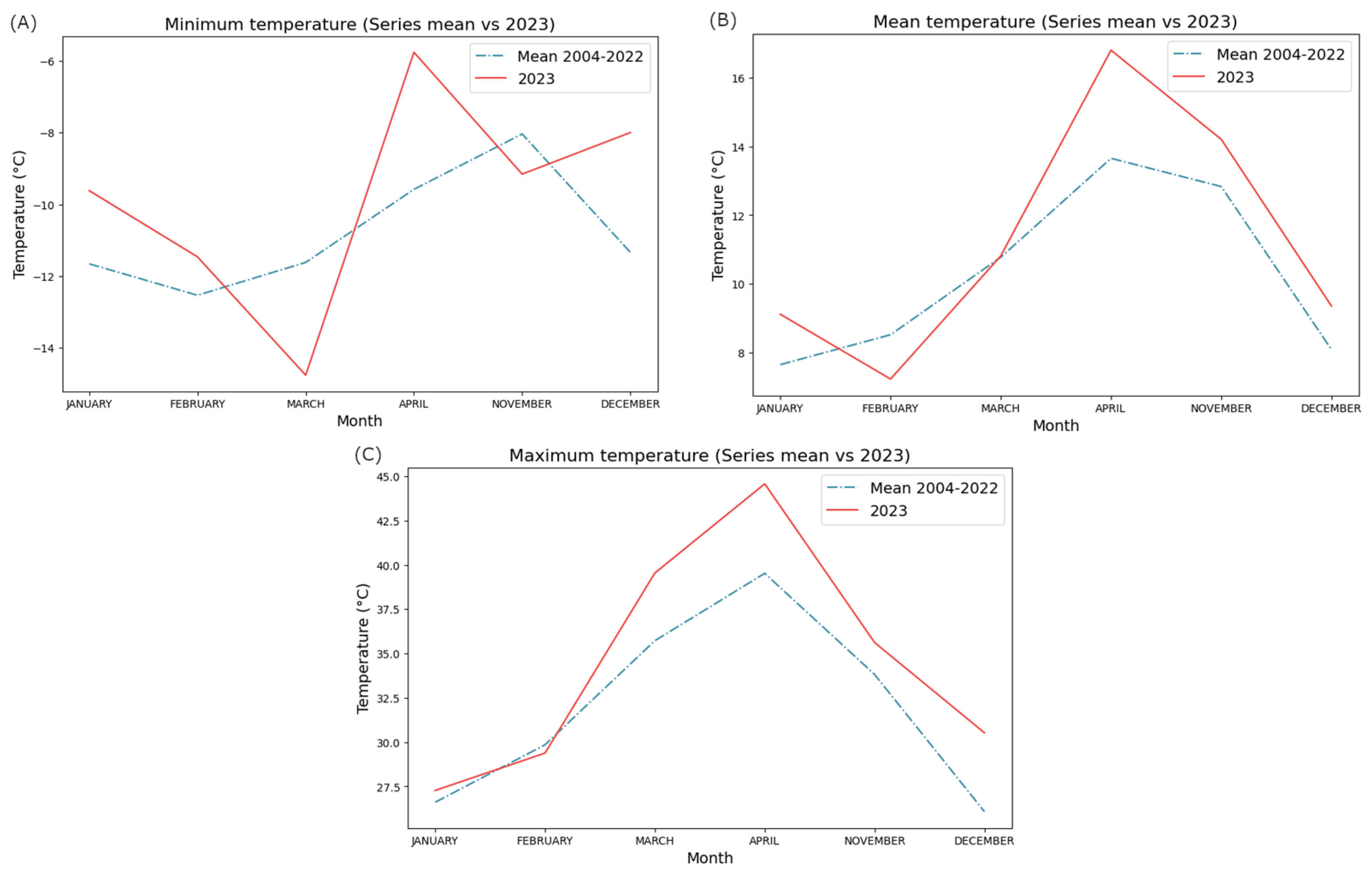

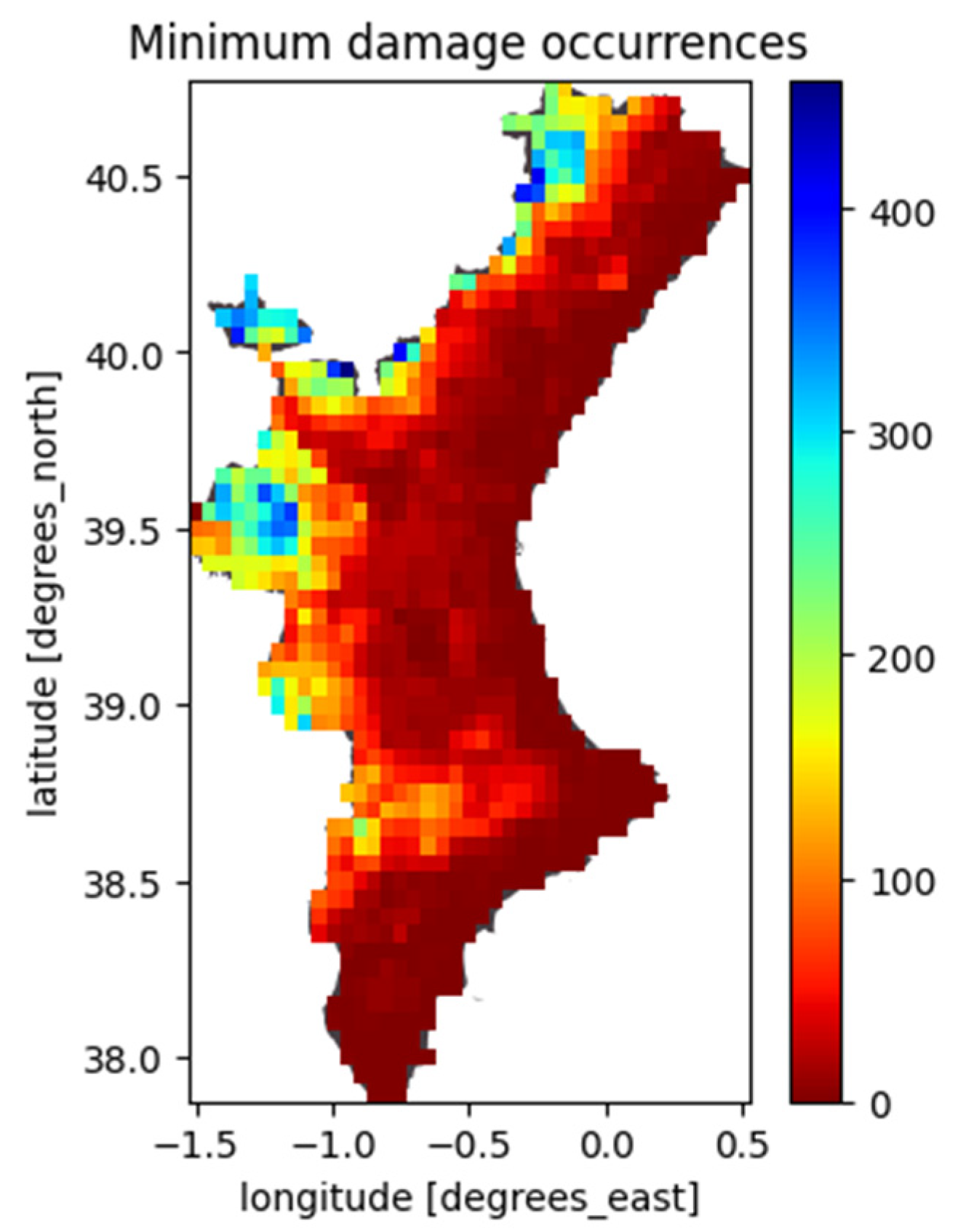
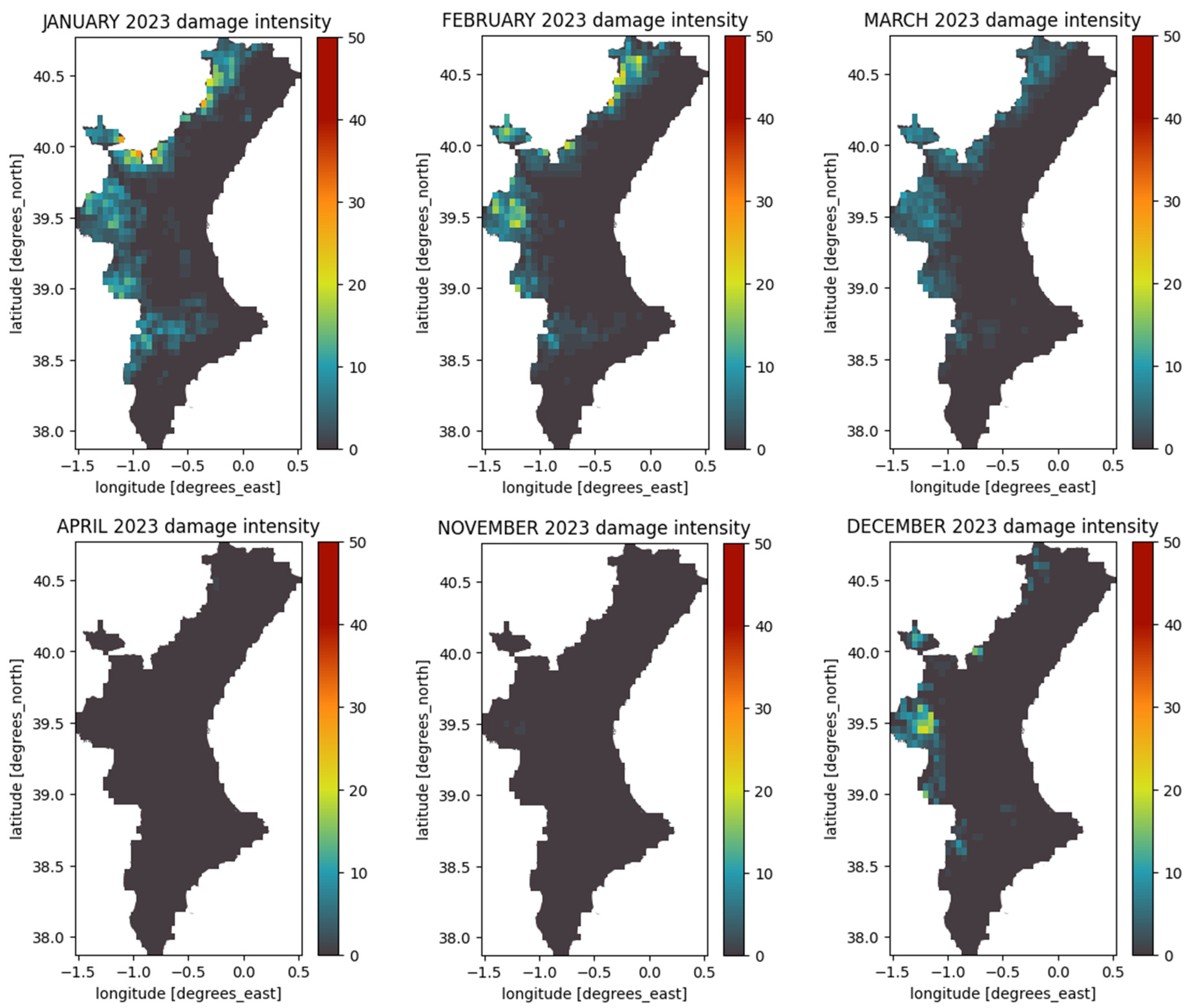
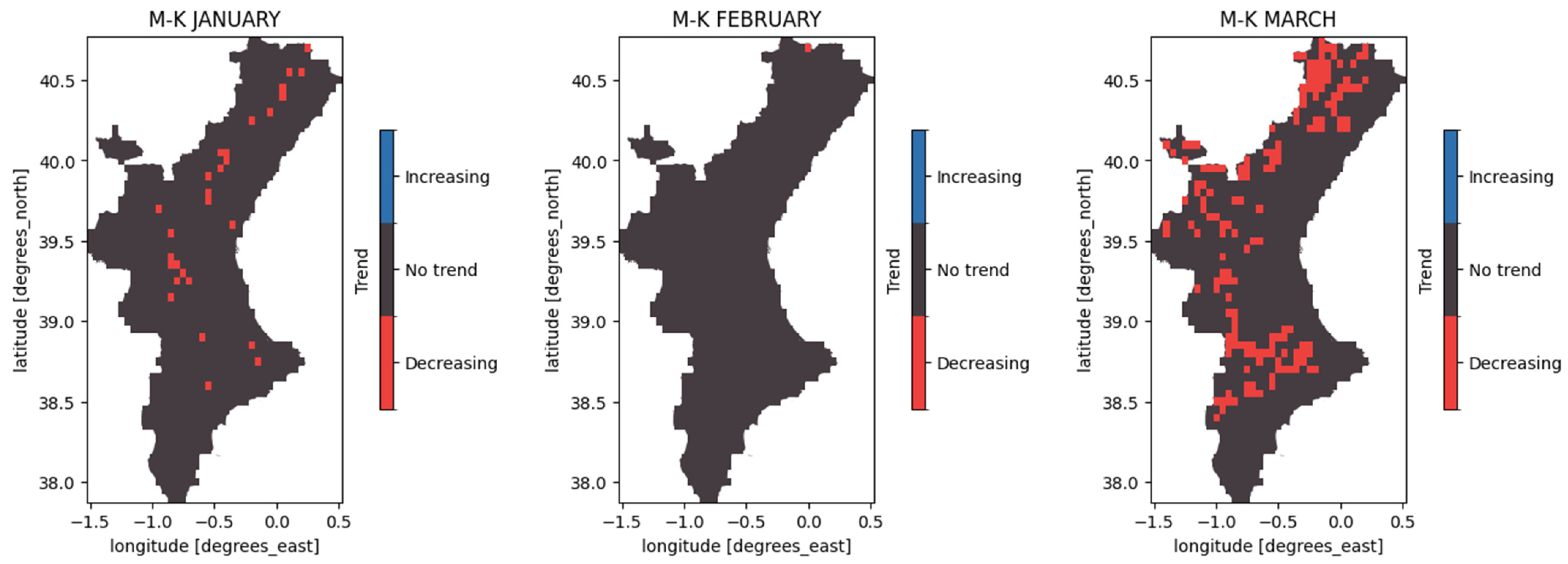
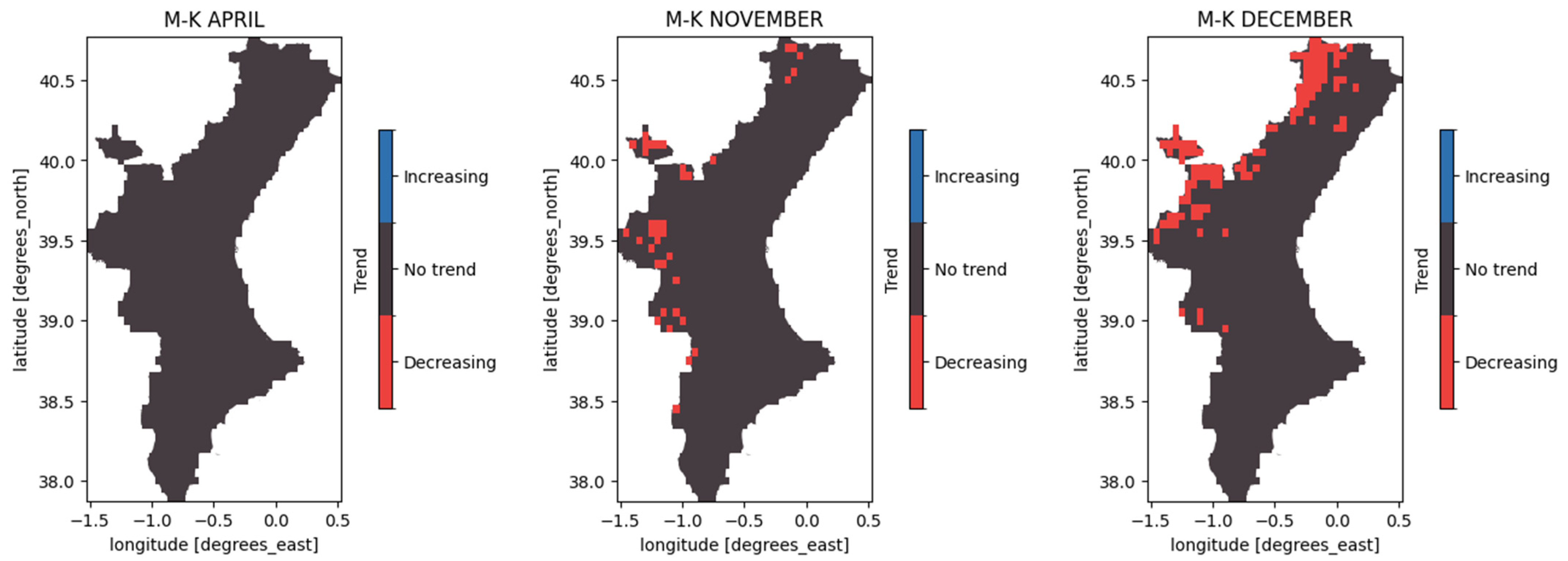
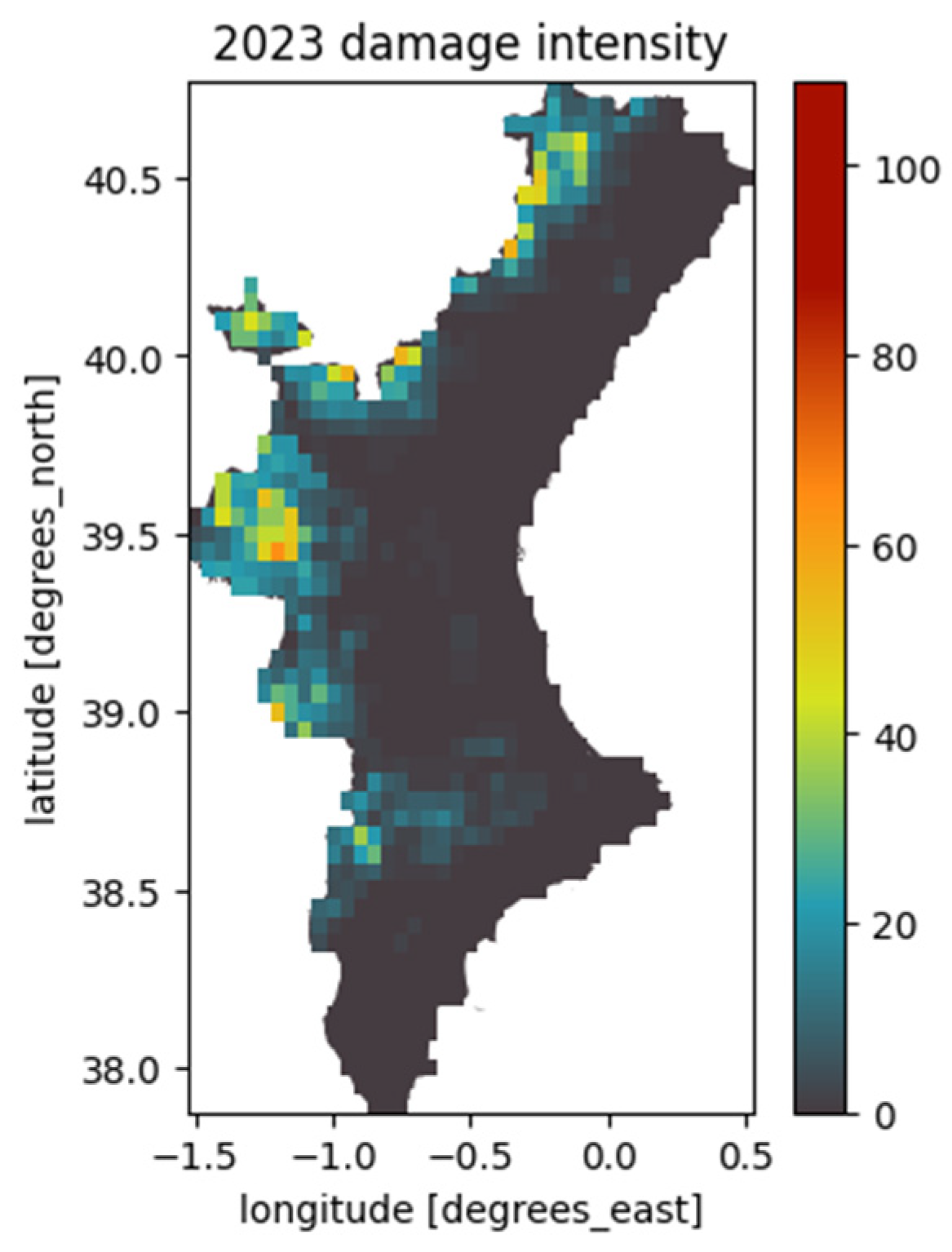
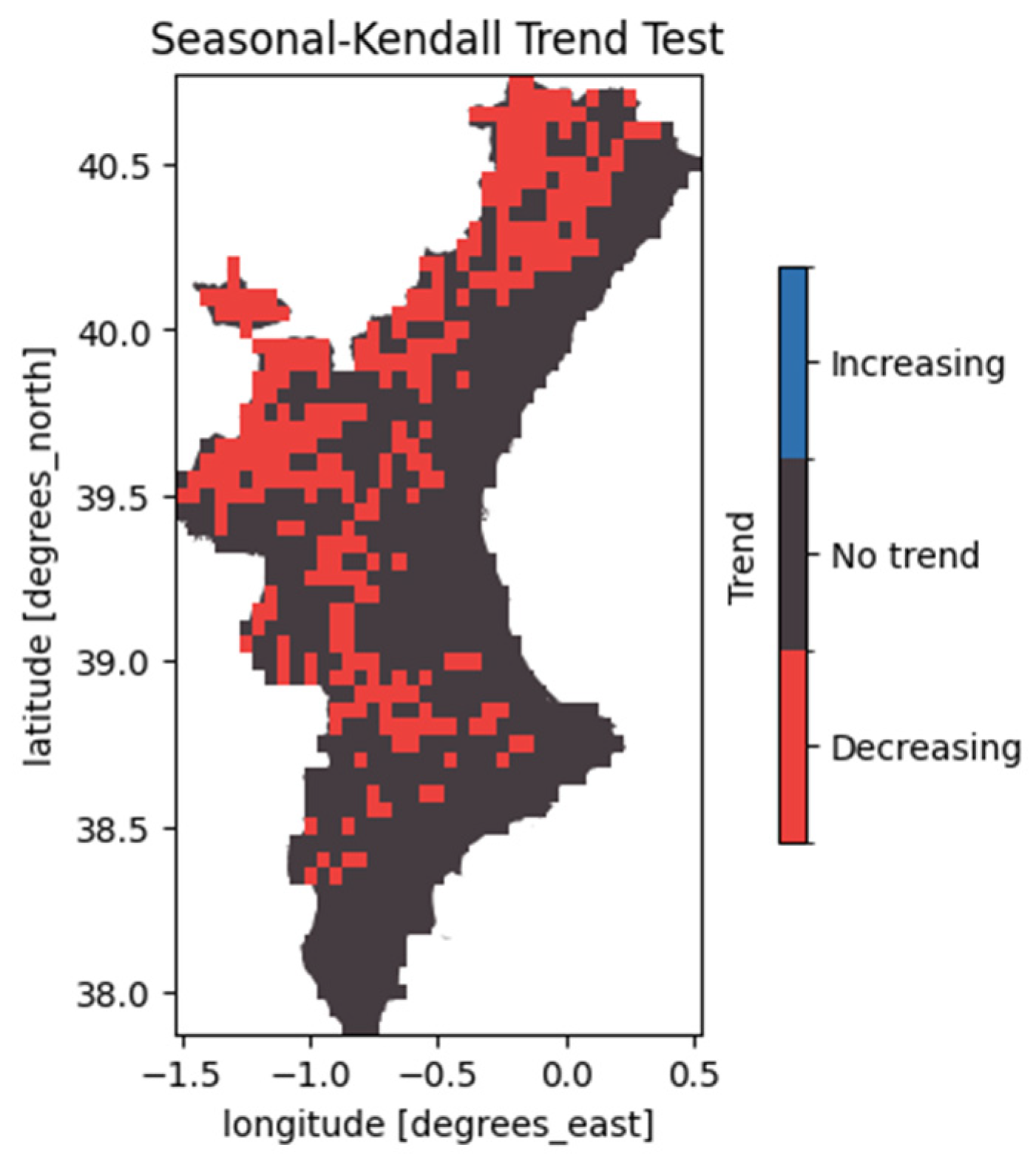
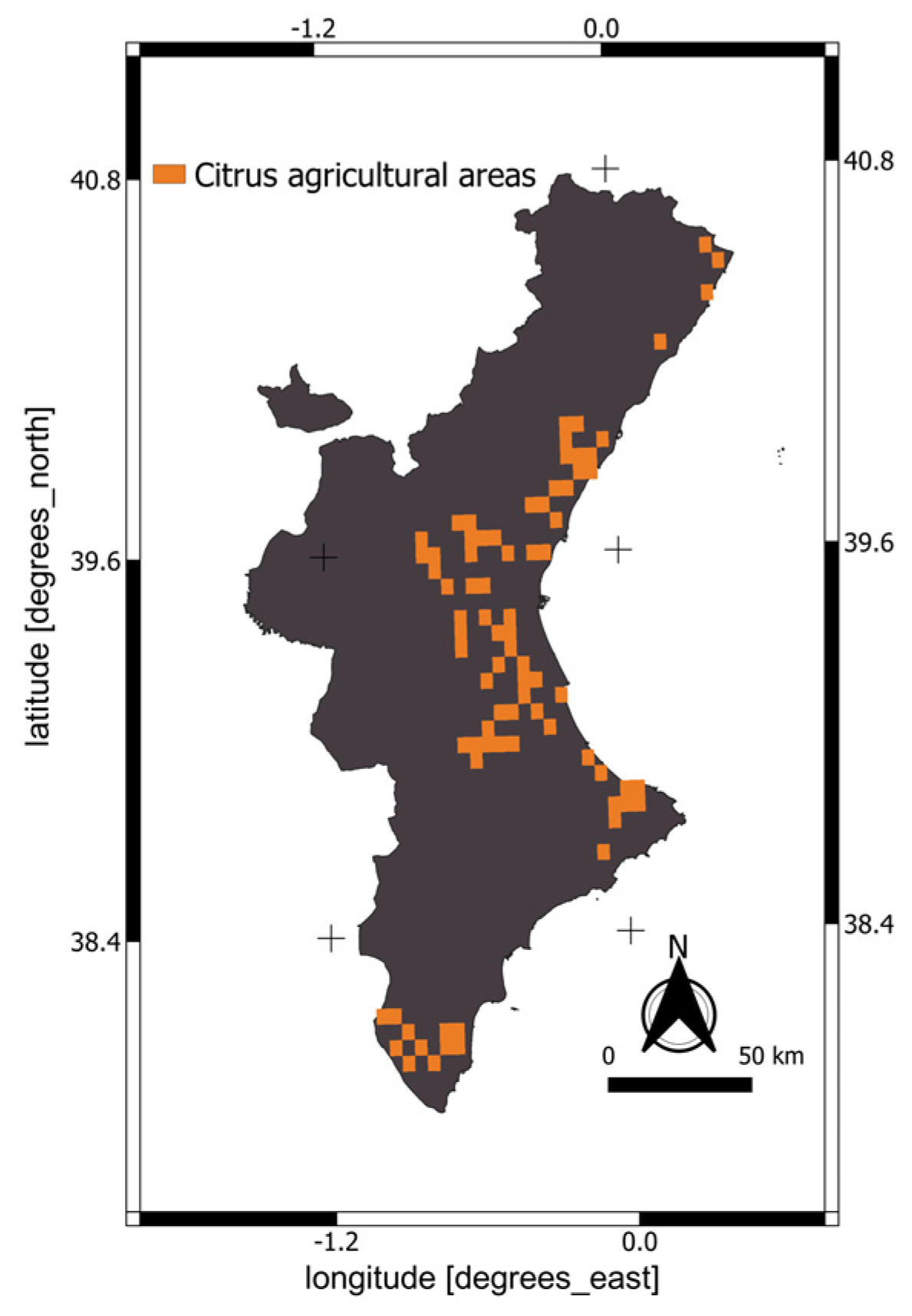

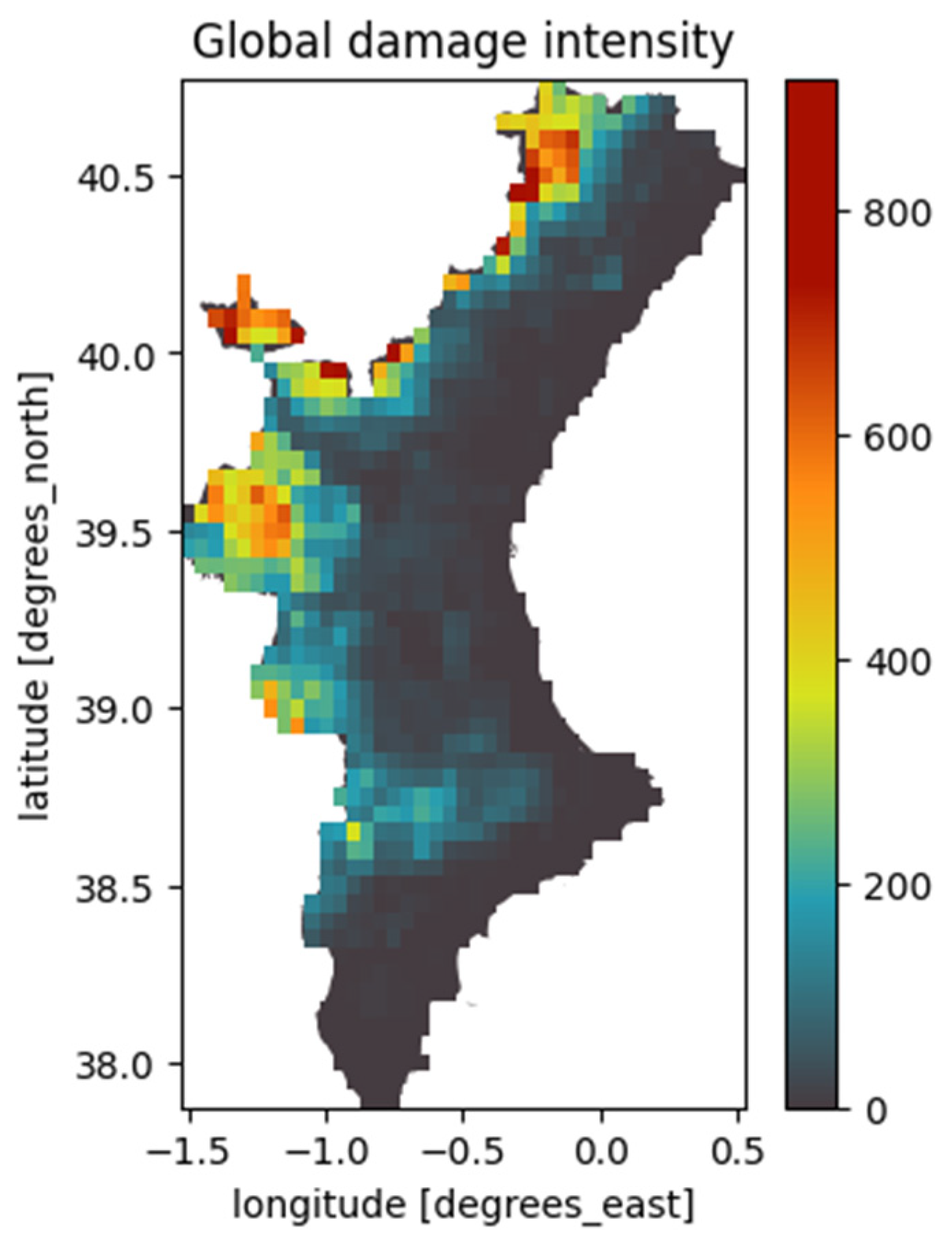
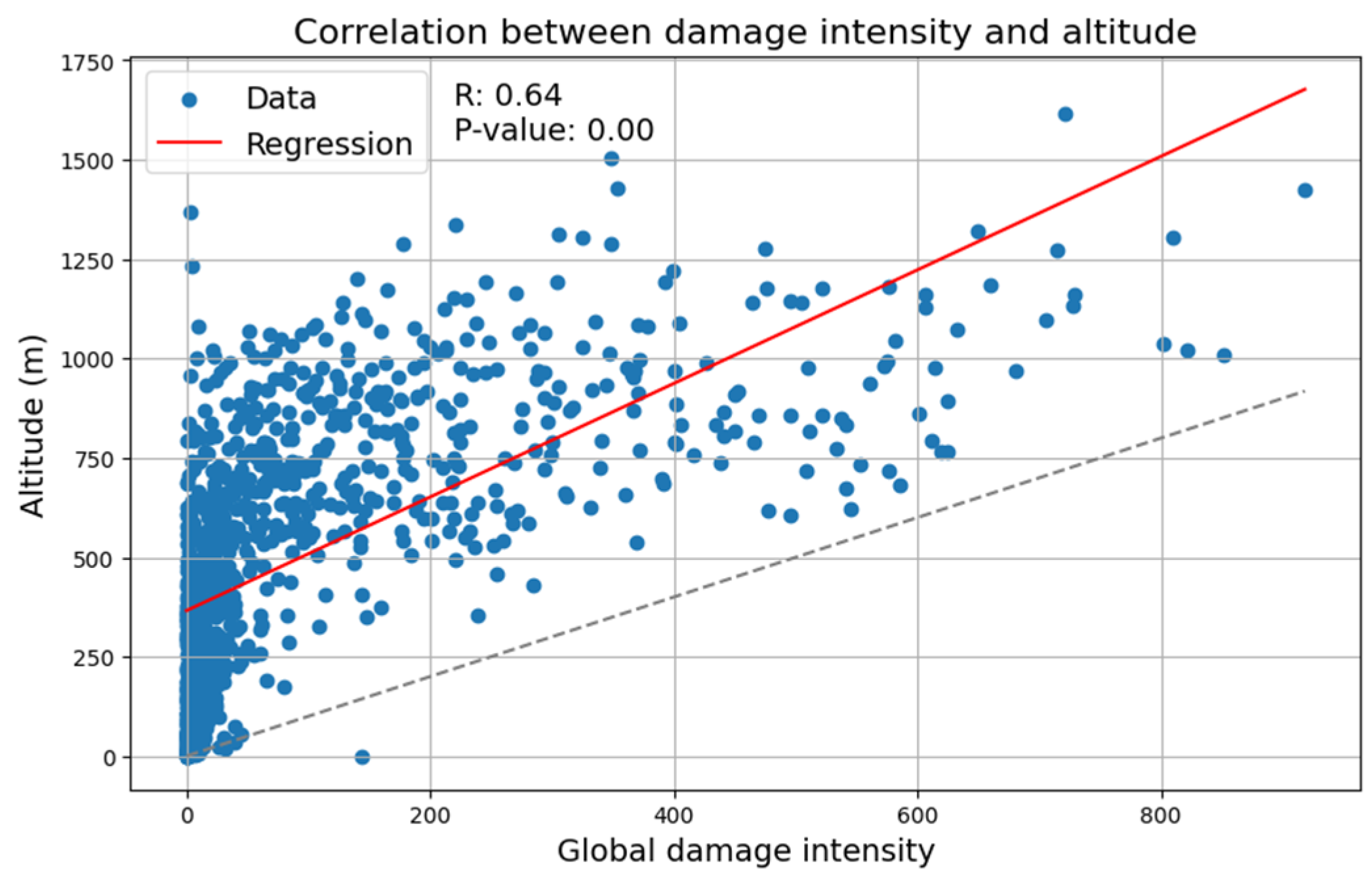
| 3 ≤ h < 6 | 6 ≤ h < 12 | 12 ≤ h < 24 | h ≥ 24 | |
|---|---|---|---|---|
| −2.3 °C | Light | Light | Moderate | Intense |
| −4.0 °C | Light | Moderate | Intense | Intense |
| −9.0 °C | Moderate | Intense | Intense | Permanent |
| 2004–2023 | 3 ≤ h < 6 | 6 ≤ h < 12 | 12 ≤ h < 24 | h ≥ 24 |
|---|---|---|---|---|
| −2.3 °C | 167 | 146 | 55 | 0 |
| −4.0 °C | 73 | 58 | 26 | 0 |
| −9.0 °C | 6 | 9 | 0 | 0 |
| Intensity (I) Levels | Pixels | Pixels with Decreasing Trend | Percentage of Pixels with Decreasing Trend |
|---|---|---|---|
| I > 0 | 856 | 310 | 36% |
| I > 50 | 317 | 161 | 51% |
| I > 100 | 194 | 125 | 64% |
| I > 150 | 129 | 97 | 75% |
| I > 200 | 76 | 64 | 84% |
| I > 250 | 50 | 43 | 86% |
| I > 300 | 30 | 28 | 93% |
| I > 350 | 10 | 10 | 100% |
Disclaimer/Publisher’s Note: The statements, opinions and data contained in all publications are solely those of the individual author(s) and contributor(s) and not of MDPI and/or the editor(s). MDPI and/or the editor(s) disclaim responsibility for any injury to people or property resulting from any ideas, methods, instructions or products referred to in the content. |
© 2025 by the authors. Licensee MDPI, Basel, Switzerland. This article is an open access article distributed under the terms and conditions of the Creative Commons Attribution (CC BY) license (https://creativecommons.org/licenses/by/4.0/).
Share and Cite
Gimeno, S.; Crisafulli, V.; Sobrino-Gómez, Á.; Sobrino, J.A. A Methodology for Estimating Frost Intensity and Damage in Orange Groves Using Meteosat Data: A Case Study in the Valencian Community. Remote Sens. 2025, 17, 578. https://doi.org/10.3390/rs17040578
Gimeno S, Crisafulli V, Sobrino-Gómez Á, Sobrino JA. A Methodology for Estimating Frost Intensity and Damage in Orange Groves Using Meteosat Data: A Case Study in the Valencian Community. Remote Sensing. 2025; 17(4):578. https://doi.org/10.3390/rs17040578
Chicago/Turabian StyleGimeno, Sergio, Virginia Crisafulli, Álvaro Sobrino-Gómez, and José Antonio Sobrino. 2025. "A Methodology for Estimating Frost Intensity and Damage in Orange Groves Using Meteosat Data: A Case Study in the Valencian Community" Remote Sensing 17, no. 4: 578. https://doi.org/10.3390/rs17040578
APA StyleGimeno, S., Crisafulli, V., Sobrino-Gómez, Á., & Sobrino, J. A. (2025). A Methodology for Estimating Frost Intensity and Damage in Orange Groves Using Meteosat Data: A Case Study in the Valencian Community. Remote Sensing, 17(4), 578. https://doi.org/10.3390/rs17040578









